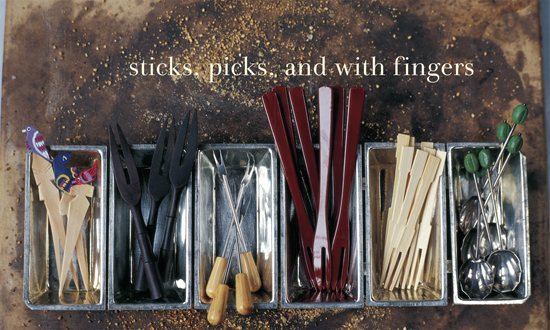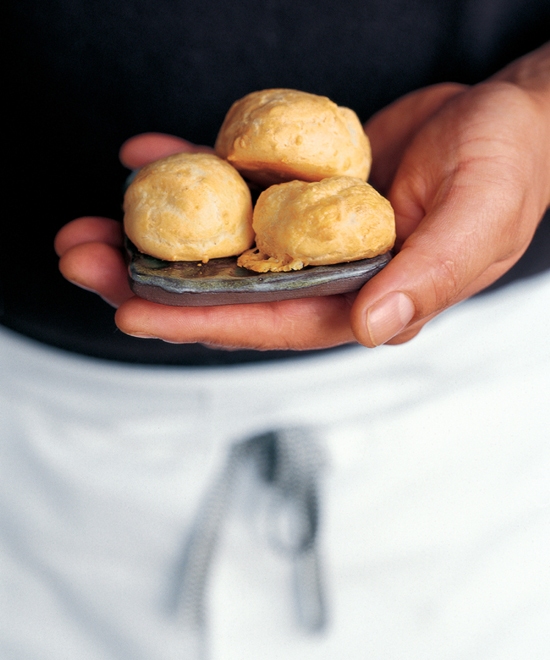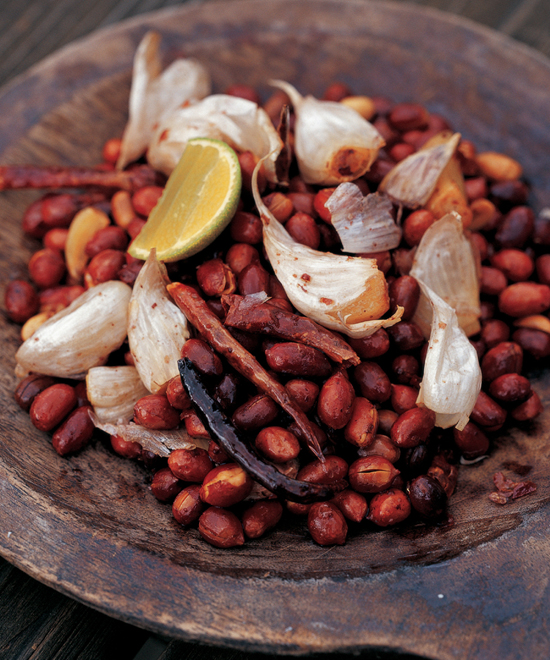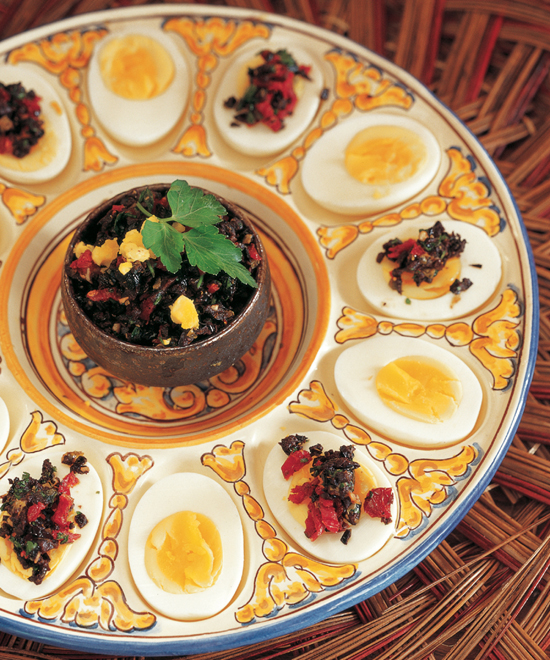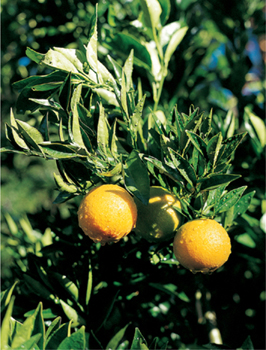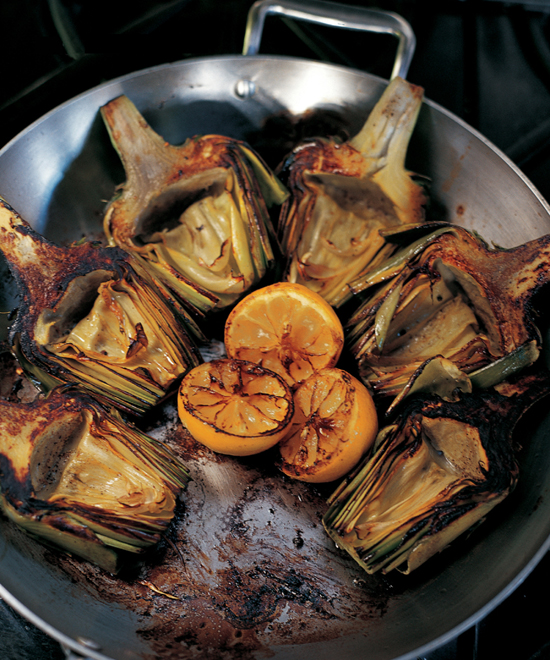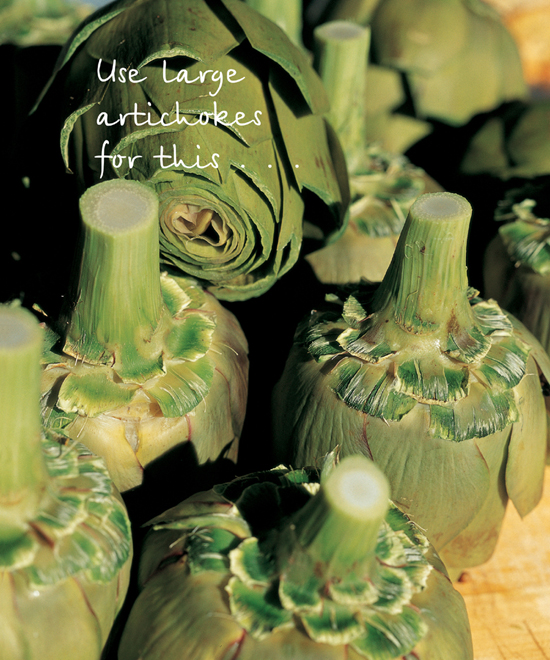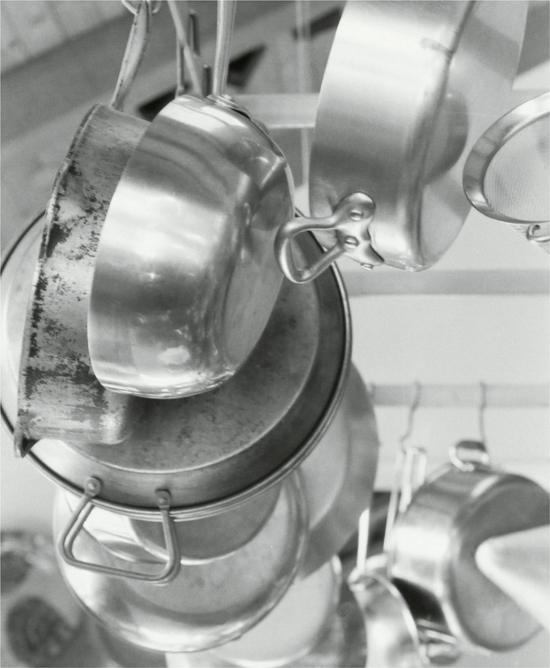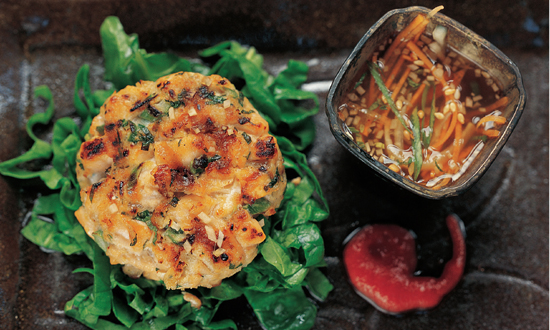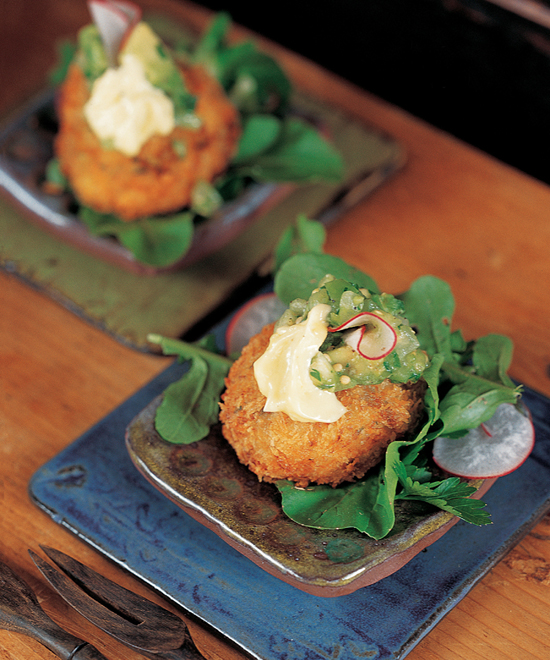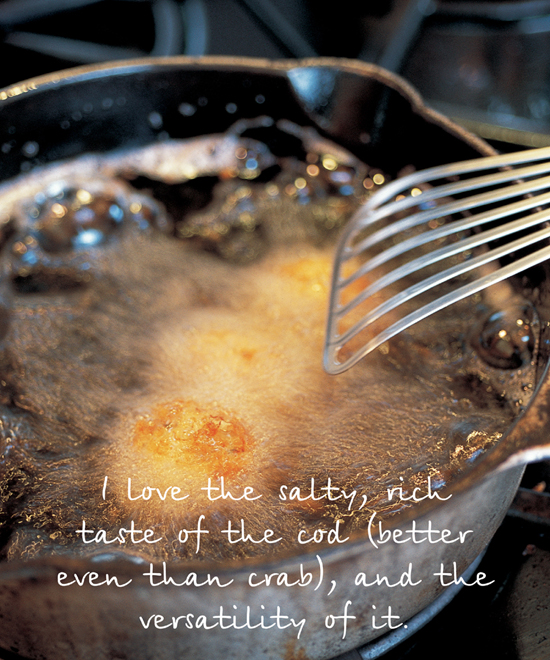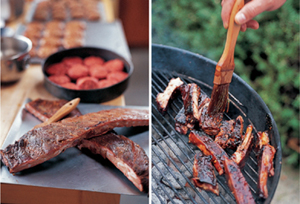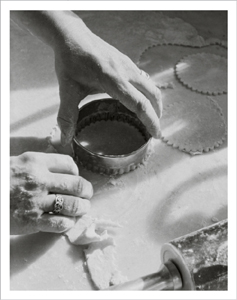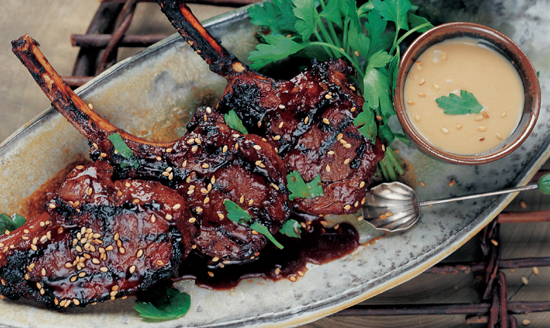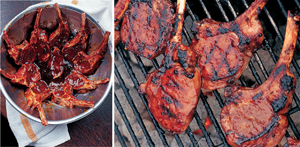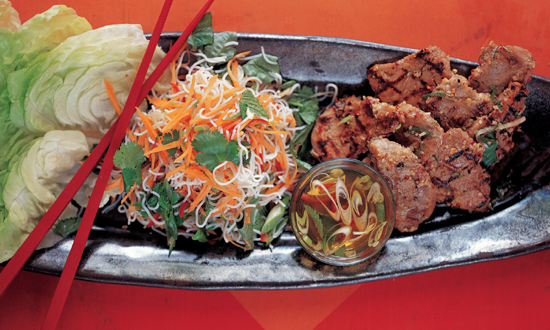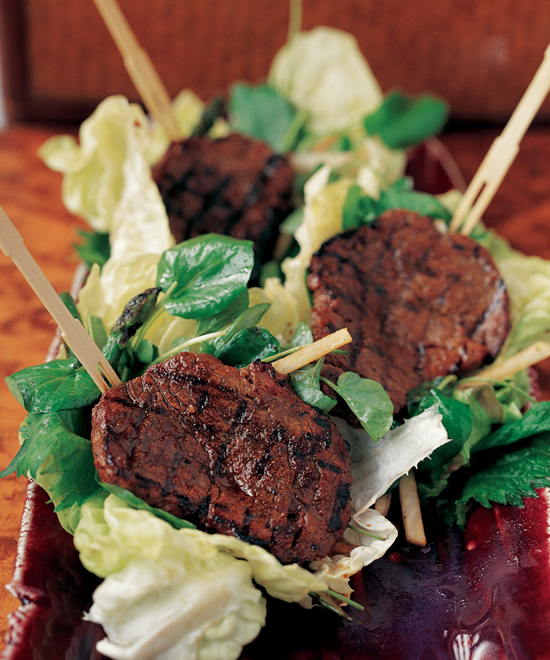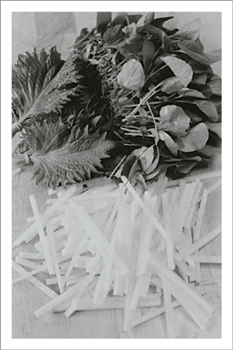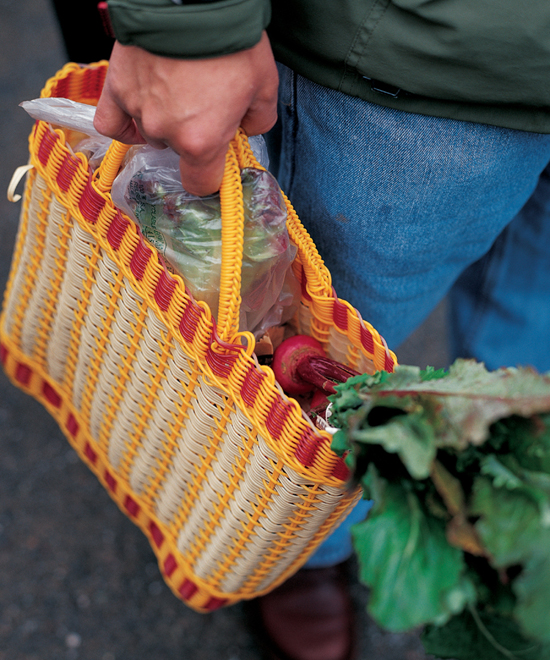chapter 1: Sticks, Picks, and with Fingers
Of all the chapters in this book, this one is my favorite because everything in it is meant to be eaten out of hand, without the benefit of knife and fork, and that’s the way I like to eat. My poor mom tried to teach me better; however, she didn’t have much success. When food was put before me, my first instinct was always to dig in with my hands. It still is.
This chapter has more recipes in it than any of the others, so there’s a lot to explore. The recipes range from very simple (Chile-Garlic Peanuts and Grilled “Street” Corn, for example) to very challenging (like the Salt Cod Cakes with Aioli or the Smoked Duck Spring Rolls). There are several dishes that are served in edible lettuce cups (just pick up the whole thing and enjoy). Some come on skewers (My Very First Beef Satay and the Serrano Ham–Wrapped Prawns, among others). Three quick tips on using skewers: (a) bamboo or wooden skewers should be soaked in enough water to cover at least thirty minutes to keep them from burning up on the grill; (b) you can break long skewers to any length that will work best for you; and (c) to keep food from twirling around or curling up on the grill, thread the food on two parallel skewers.
Any dish in this group would make a good starter for a small-plates meal, or you could serve three or four of them together for an all-appetizer, no-knives-and-forks-needed meal. They would all be excellent for cocktail parties, wine tastings, or buffets, as well. Just remember that for passed hors d’oeuvres, you want bite-size morsels of food and short skewers (three or four inches at most). Put out plenty of napkins or wipes for your guests.
There are choices for every season here, so come back to this chapter often.
Gougères
Serves 6 (makes about 60)
Jennifer Palmer is one of the best pastry chefs I’ve ever worked with. She makes these cheese puffs every Christmas Eve, and I look forward to them each year. Her trick is to place a small slice of cheese on top of each one before she bakes them. Delicious! Hot out of the oven, they are addictive … and one of my favorite Christmas treats.
You are completely dependent on an excellent cheese to make this dish memorable, so don’t cut corners on the cheese. Inexpensive Gruyère often has an odd gym-sock aroma that just ruins anything you make with it. Try one of the many wonderful cave-aged Gruyères from Switzerland. Tomales Bay Foods carries one called Emmi that has a wonderful nutty taste. Just be sure to get the tastiest Gruyère you can.
4 or 5 large eggs
Pinch of salt, plus ¼ teaspoon for the gougères
¾ cup water
⅓ cup butter
¾ cup flour
¾ cup finely grated Gruyère cheese
Preheat the oven to 375°F to 400°F.
, beat 1 of the eggs with a pinch of salt and set it aside. For the gougères, combine the water, butter, and ¼ teaspoon salt in a saucepan and bring it to a boil. Reduce the heat, add the flour, and whisk until the batter comes away from the sides of the pan. Cook for 1 to 2 minutes longer. Transfer to a mixer bowl and beat in 3 of the eggs, 1 at a time, beating till smooth after each addition. Add the last egg only if the batter seems too thick. The dough should be like a thick cookie dough. Stir in the Gruyère, saving a little to sprinkle on the top before baking.
To finish the gougères, line a baking sheet with parchment paper and pipe or spoon the batter onto it, about a teaspoon of batter for each. Brush with the egg wash and sprinkle with the remaining cheese. Bake until golden and puffed, 12 to 16 minutes.
Makes 30 crackers (serves 6)
Once you start munching on these crispy, cheesy crackers, you will not be able to stop. They are that good. At the restaurant, we use them to garnish soups. They are great floated on or served alongside pureed soups of all kinds. The dough keeps well in the refrigerator and unbaked frozen crackers will keep for 3 months, so these are great to have around to handle those situations when you have unexpected guests.
You can roll the dough out flat and cut the crackers into any interesting or fun shape you wish. Or you can roll the dough into a log and slice it up. If you want to add a little extra, roll the log in some seeds, nuts, or spices.
8 ounces white Cheddar cheese, grated
2 ounces blue cheese
½ cup butter
1 cup flour
¼ cup whipping cream
1 teaspoon sugar
½ teaspoon salt
Aniseed and fennel seeds, coarsely crushed
1 tablespoon sea salt plus
½ teaspoon cayenne pepper
Poppy seeds
Freshly ground black pepper
Sesame seeds, black or white
Sliced almonds
Place the cheeses, butter, flour, cream, sugar, and salt in a food processor or mixer bowl and process or mix with the paddle attachment until a ball forms. Of course, this could also be done by hand, but it will take a bit more effort.
Roll the dough into a log and wrap it in plastic wrap. Tap and turn the log against the countertop a few times to form a triangle shape. Chill the dough for at least 1 hour (as long as overnight is okay). If you’re going to dress the crackers up with seeds or nuts, spread them out on a baking sheet and press the dough into them. Cut the dough into ¼-inch-thick slices. Dipping the knife into hot water first will make the job easier.
Alternatively, chill the dough and roll it out to ⅜-inch thickness and cut out 2-inch circles with a cookie cutter. Press the scraps together and roll them out to make more circles. If you’re making these ahead, place the disks on a baking sheet and freeze.
When firm, put them in freezer bags and return them to the freezer.
, preheat the oven to 375°F. Line a baking sheet with parchment paper and arrange the crackers on it, allowing some space between them because the dough will spread. Bake 8 to 10 minutes in a convection oven, 10 to 12 minutes in a conventional oven, until cooked through and crisp and brown around the edges.
Serves a crowd (makes 1 pound)
These are a great cocktail nibble, and they’re quick and easy to make. I keep hazelnuts in my freezer and do this whenever my guests have the munchies and the meal isn’t ready yet. Don’t worry about removing the skins on the hazelnuts. You can get fancy by mixing a little cayenne pepper, toasted ground cumin seeds, or chipotle chile powder into the salt just before seasoning the nuts. Be sure to season them when they are hot
Almonds, walnuts, and pecans can also be pan-roasted; just reduce the cooking time.
Olive oil
1 pound fresh hazelnuts
Coarse sea salt (Maldon flake salt is the best)
Pour oil to a depth of ⅛ inch into a heavy-bottomed skillet. Heat over medium heat; when the oil is hot, add the nuts. Stir continuously but slowly till golden brown, 8 to 10 minutes. Drain on paper towels and sprinkle with sea salt while they’re still hot. Best served warm.
Chile-Garlic Peanuts
Makes a big bowlful
The peanuts you want for this traditional Oaxacan bar snack are the short round guys with red skin that are known as Spanish peanuts. The American peanut is a bit longer than the Spanish peanut and has a brownish skin. It will work, too; it just doesn’t quite have the look. For the chiles, any small hot dried chile will do, but I especially like chiles de árbol or chiles pequín for this.
Traditionally these are cooked in pork lard. Although we norteños eat them like crazy when we go south of the border, few of us cook with lard at home anymore. A peanut or vegetable oil would work well also. You just need something with a high smoke point, because you want the oil really hot when the peanuts, chiles, and garlic hit it. I often use a double-handled pan to make shaking the nuts easier as they’re cooking. A wok would also work.
Two pounds of peanuts may sound like a lot, but I guarantee the whole batch will disappear quickly, especially if you serve them warm. You can make them in two batches if it is easier for you.
2 whole heads garlic
¼ cup peanut or vegetable oil
2 pounds shelled raw Spanish peanuts, with skins
2 to 4 fiery-hot dried chiles, slightly crushed
1 tablespoon kosher salt
Grated zest and juice of 1 lime
Separate the heads of garlic into cloves. Trim off the root ends, but don’t peel the cloves. Put the oil in a pan large enough to hold everything, and heat it until it is almost rippling. Add the peanuts, garlic, and chiles; cook, stirring and shaking continuously, for 10 to 12 minutes, until the peanuts have darkened. Add the salt and lime zest and juice to the pan and give it another good stir and shake. Pour out into a serving bowl and watch them go!
Mustards’ Famous Onion Rings with House-Made Ketchup
Serves 6
Boy, do I get grief for having left this recipe out of the Mustards Grill cookbook! Who would have thought that people would actually want to make onion rings at home? Well, here’s the recipe, along with directions for making a super ketchup that we always serve with them. This ketchup is also a great complement for hamburgers, meat loaf, and, of course, french fries.
Making good onion rings is mainly a matter of technique. First of all, you need to slice the onions very, very thinly; they should be thin enough so you can see through them, but not too thin. You may need to experiment on the thinness—too thin and they will burn, too thick and they will get soggy. Really, unless you are the best slicer in the world, you should use a mandoline or an electric slicer for the onion cutting. Timing with the flour coating is crucial, too: you can’t let the onion rings sit too long in the flour or they will become gooey (not good). So don’t flour more onions than you can fry in one batch. And this may be tricky, but you should have the oil ready—at 375°F—so the onion rings come out of the flour and go right into the hot oil. Finally, you need to keep the onion rings moving freely while they’re frying, turning them gently with tongs.
As for the ketchup, I’ve been playing with ketchup recipes for at least twenty years. This is one of my favorites. The secret ingredient in this one is apples—they add sweetness to the ketchup, and the pectin in them adds texture and gives it a natural body so the ketchup really clings to fries and onion rings. We use Sierra Beauty apples or Granny Smiths. It’s really wonderful with McIntosh apples, too, but their season is very short. Green apples should be peeled, but don’t bother peeling the red-skinned ones. Use a high-quality, good-tasting vinegar that tastes and smells of apples. You could cut the recipe in half, but it’s so good, you’ll wish you hadn’t.
3½ pounds tomatoes, peeled and chopped
1 to 1¼ pounds apples, cored and chopped
3 onions, chopped
1½ cups sugar
2 cups cider vinegar
1 tablespoon sea salt
½ teaspoon cayenne pepper
6 black peppercorns
6 allspice berries
6 cloves
Peanut or vegetable oil, for frying
3 cups flour
1 tablespoon salt
6 large yellow onions, thinly sliced
3 tablespoons minced chives or scallions
, combine all the ingredients in a large stainless steel pot and bring to a boil. Reduce to a simmer and cook, uncovered, about 2 hours, until it is the consistency of commercial ketchup. Allow it to cool slightly, then puree in batches in a blender until very smooth. Return to the heat for several more minutes to thicken further. Stir often during this final cooking. Strain and cool.
, heat at least 3 inches of oil to 375°F in a heavy straight-sided pot. Combine the flour and salt in a large stainless steel bowl and mix well. Now toss in a few slices of onion and separate the slices by hand into individual rings. Get all the rings coated with some of the flour-salt mixture and transfer them to a strainer. Shake with abandon over the bowl to remove excess flour. Do this longer than you think you should, again separating any clumps with your fingertips.
Transfer some of the rings to the frying basket. It is very important not to overcrowd the pan, so start with just a few to get a feel for the process. Check the oil temperature to be sure it’s at 375°F, then carefully lower the basket into the hot oil. Keep the rings moving almost constantly, using tongs to lift, separate, and turn the rings in the oil as they cook. Use a light touch here, as you don’t want to mash the onion rings together, which would probably result in a gummy mess. Carefully remove the onion rings when they are golden brown and crisp. This takes us about 1 minute at the restaurant, but we are very practiced and can do 80 to 90 orders per shift. Shake the excess oil from the cooked onion rings onto paper towels, and pile them up on a big plate. Check the temperature to be sure the oil is still at 375°F and repeat with the remaining onion rings, frying them in as many batches as necessary. Sprinkle with the chives, and serve immediately with some ketchup on the side.
Here’s the equipment you will need for making perfect onion rings.
• Mandoline or electric slicer
• Large, stainless steel bowl
• Electric deep-fat fryer
• Wire basket or strainer
• Long-handled tongs
Note: If you don’t have an electric fryer, you can use a heavy, straight-sided pot, but it should be deep enough that the top of the pot is three to four inches above the level of the oil, and your wire basket should fit at least three-fourths of the way into the pot. You’ll also need a candy or deep-fry thermometer to monitor the temperature of the oil.
Plantain Chips with Cindy’s Backstreet Kitchen Mojo and Creamy Cilantro-Garlic Dip
Serves 6 (makes about 3 or 4 dozen chips)
Unlike the regular bananas we are so used to eating here in the United States, plantains cannot be eaten raw. Though they are a fruit, they are most often treated like a starch. They are very, very versatile, like potatoes, and can be boiled, baked, stewed, sautéed, grilled, or, as in this recipe, deep-fried. They can be used at any stage of ripeness, too, from green to yellow to black-ripe: it all depends on the recipe. For this one, you want the very green unripe ones. Plantains grow in most tropical areas of the world, but they are most popular in the Latin American countries and in the Caribbean. You can find plantains at Latin American and Asian markets.
The secret to this recipe is to get the plantains sliced consistently thin. Not paper-thin, but about one-sixteenth to one-eighth of an inch thick. I highly recommend you use a mandoline for this job. My favorites are the Japanese mandolines with carbon steel blades, which you can get in most cookware stores.
A mojo (pronounced “mo-ho”) is a salsalike sauce, very common in the Caribbean and in Central and South America, especially Cuba and Brazil. It is often made with the juice of Seville oranges, or bitter oranges, as they are also known.
Mojos
tend to be much thinner than Mexican-style salsas and very full-flavored, and they make a great dip for grilled or fried foods. They are not usually cooked or pureed, but I do make this one in a blender. Mojos
are good for adding zip to dishes. The word mojo
comes from the Portuguese molho,
which means simply “sauce.”
1 cup mayonnaise
1½ teaspoons minced garlic
¼ bunch cilantro, leaves and tender stems, coarsely chopped
2 tablespoons capers, rinsed and minced
¼ teaspoon salt
⅛ teaspoon freshly ground black pepper
12 small cloves garlic
¼ teaspoon sea salt
¼ cup freshly squeezed bitter orange juice, or ¼ cup sweet orange juice plus 2 tablespoons lemon or lime juice
1½ teaspoons toasted ground cumin seeds
½ cup extra virgin olive oil
¼ teaspoon freshly ground black pepper
3 very green unripe plantains
Ice water
Salt, for seasoning the chips
Peanut or vegetable oil, for frying
1 or 2 limes, cut into wedges
, combine all the dip ingredients in a small bowl and mix well. Chill and reserve until needed.
For the mojo, put the garlic and sea salt in a blender and pulse until finely chopped. Blend in the bitter orange juice and cumin, and process finely. With the blender running, slowly add the oil in a steady, thin stream, and continue processing until the mojo is emulsified. Season with pepper.
, cut off the tips and remove the peel. You may need to make a few lengthwise slits along the ridges of the peel to loosen it first. Have a container of ice water ready for soaking the sliced plantains. Add a few shakes of salt to the water. Slice the plantains lengthwise about ⅛ to 1⁄16 inch thick, and soak them in the ice water for 15 to 20 minutes. Drain the plantains. To fry the plantains, pour the oil to a depth of 1½ inches into a heavy-bottomed frying pan and heat to 365°F. Carefully lower a few slices of plantain at a time into the oil, taking care not to overcrowd the pan. Fry for about 1 minute until crisp, remove to paper towels to drain, and salt while hot. Allow the oil to return to temperature before frying the next batch.
Serve the plantain chips like potato chips, with separate ramekins of the dip and the mojo, and plenty of lime wedges for squeezing.
Papas Bravas
Serves 6
Loosely translated,
papas bravas means “spicy potatoes.” In this dish, the potatoes are like french fries, and the smoky, sweet-hot, garlicky sauce that comes with them is the brava part.
Papas bravas is a favorite in tapas bars all over Spain. It’s usually served with toothpicks, which makes for a lot of sauce dripped all about—somewhat messy, but the sauce is so addictive, nobody cares. For a truly authentic sauce, use Spanish pimentón paprika, Spanish olive oil, and, if you can get them,
ñora peppers.
Ñoras are medium-hot dried red peppers, often used in stews and sauces. You can grind them up in an electric coffee grinder; just be sure to clean it up well afterward. If you end up with any leftover brava sauce, it’s great on just about anything from fried eggs to pork chops to scallops.
The best potatoes to use for this dish are small new-season potatoes—white-skinned, Yukon Gold, Kennebec, fingerling. Just don’t use red-skinned potatoes because they don’t fry up well, and they tend to absorb oil. The potatoes need to be boiled or steamed before you fry them.
2 tablespoons ground dry ñorapeppers or mild sweet chili powder
1 to 2 tablespoons smoky or sweet pimentón paprika or other paprika
3 cloves garlic, peeled and minced
1½ tablespoons sherry vinegar
Tiny pinch of toasted ground cumin
Tiny pinch of cayenne pepper
1 cup very ripe chopped peeled tomatoes
1 teaspoon sea salt
⅓ cup extra virgin olive oil
12 to 18 small potatoes (about 2 pounds)
Olive oil, for frying
Additional sea salt
Combine all the sauce ingredients in a blender and blend until smooth. Reserve until needed. (The sauce can be made up to 24 hours ahead. Refrigerate it, but bring it back to room temperature before serving.)
You can peel or not peel the potatoes, as you wish. Either way, steam them or boil them in salted water till just fork-tender: 15 minutes will do it for small fresh potatoes. Drain them well and cut them in half lengthwise.
Pour the oil to a depth of about ½ inch into a heavy saucepan large enough to hold all the potatoes comfortably. If necessary, get a second pan going, as you want to fry all the potatoes at once. Heat the oil to 375°F and fry the potatoes till crisp on the bottom; flip them over and repeat. Don’t stir them around a lot.
As they finish, scoop the potatoes out with a slotted spoon, and toss them into a stainless steel bowl, sprinkling them with salt as you go. When they are all done, scoop them onto plates, smother liberally with the sauce, and serve immediately. Papas bravas should be hot enough to burn your tongue if you forget to blow on them first.
Serves 6
It takes a lot of space to grow corn, so we can manage only three small patches of corn in the Mustards Grill garden. In the summer when the corn is in, we can sell out of a day’s harvest in less than an hour. People get so excited, whatever we have blows out before lunch is over. Some of our guests have even been known to eat three whole ears of our grilled corn as their lunch. We grill it with the husk on. This way, the corn creates its own steam, which intensifies the flavor. It’s the best!
For the skewers, you need something fairly substantial. The ones we use in the restaurant look like skinny pencils, but then we are skewering whole ears of corn. The skewers meant for caramel apples would work well, or you could dig out those corn holders hiding at the back of your kitchen drawer.
We call this “street” corn because it’s the kind of corn Oaxacan street vendors sell. As a small plate, I’d plan on half an ear of corn per person … but go ahead and double or triple up your servings if you want to be more generous.
3 to 4 tablespoons homemade or high-quality mayonnaise
½ teaspoon minced garlic
½ teaspoon salt
½ teaspoon cayenne pepper
¾ cup grated Parmesan cheese
3 ears garden-fresh corn, husks left on
1 lime, cut into 6 wedges
Stir the mayonnaise and garlic together in a small dish. Mix the salt and cayenne together in another small dish or in a spare salt shaker if you have one. Put the Parmesan on a small plate (you’ll be rolling the corn in the cheese). Have this all ready for when the corn comes off the grill.
When you’re ready to serve, grill the corn over a hot fire 12 to 15 minutes, rolling it around so it cooks evenly. If you have other food to grill for the meal, move the corn to the side of the grill when it’s done, turning it now and then while it’s offstage. Or you could put the corn on a platter and cover it with a kitchen towel. To serve, shuck the corn and break each ear in half. If the corn has cooled down too much, quickly run the cobs over the grill. Stick corn holders on the ends of each piece or push wooden skewers through each end. Brush with mayonnaise, dust with the salt and cayenne mixture, and roll in the Parmesan, being sure to get a nice coating on each little corn. Serve warm with lime wedges for individual squeezing.
Three-Cheese Croquettes with Quick Mustard Sauce
If you let people dip, this would be a good hors d’oeuvre.
Serves 6
This recipe goes way back to the early ’80s and the beginning of my small-plate addiction, but I still really love them. The base is nothing but a very thick béchamel sauce made with lots of cheese. The recipe calls for Parmesan or Gruyère cheese, goat cheese, and Jarlsberg cheese, but you can use your favorite cheeses, or even clean out the cheese drawer of your fridge. It’s best to form the croquettes themselves ahead, and fry them up at the last minute. Make them small so they’ll fry quickly.
If you have any leftover mustard sauce, it is great with grilled steak, smeared on bread for ham and cheese sandwiches, or served with pork chops. The Double-Basil Tomatoes would be really good in addition to or in place of the mustard sauce.
1 tablespoon Dijon mustard
1 tablespoon coarse-grained mustard
1 tablespoon prepared creamy horseradish
2 tablespoons half-and-half
1 to 2 tablespoons water
¼ cup butter
½ cup flour, plus 1 cup for coating croquettes
1½ cups whole milk
1 cup (packed) grated aged Parmesan or Gruyère cheese
½ cup grated Jarlsberg cheese
1 ounce soft fresh goat cheese
1 tablespoon minced fresh tarragon or 2 tablespoons minced fresh chervil
2 tablespoons minced chives Salt and freshly ground white pepper
Cayenne pepper
1 large egg
1 tablespoon water
1 to 1½ cups fine bread crumbs
Peanut or vegetable oil, for frying
1 tablespoon rice vinegar
3 tablespoons extra virgin olive oil
Pinch of salt
Pinch of freshly ground black pepper
3 cups chervil sprigs, watercress, or mixed fresh basil and tarragon (small leaves only)
, mix together the mustards, horseradish, and half-and-half, then whisk in just enough water to make the sauce thin enough to drizzle. Reserve in the refrigerator until needed.
, melt the butter in a saucepan over medium heat, and add ½ cup of the flour. Cook and stir 2 to 3 minutes, until you get a nutty aroma. It is important to cook this roux long enough to avoid a raw-flour taste, but you don’t want it to brown. Gradually add the milk, stirring all the while, and cook over low heat until the mixture is very thick. Stir well to avoid
lumps. When thickened, add the cheeses, and stir until they have melted and the batter is smooth and uniform. Stir in the tarragon and chives, and season with salt, white pepper, and cayenne pepper. Remove from the heat and pat out on a large plate or pan; refrigerate 2 to 3 hours, until thoroughly chilled.
Use a soupspoon to form the croquettes. Dip it in ice water, scoop out a bit of batter, and roll the batter into a little lozenge shape. Repeat until you’ve used up all the batter. Chill again.
, combine the egg and water in a small bowl to make an egg wash. Put the remaining 1 cup of flour in a shallow bowl and the bread crumbs in another. Roll the croquettes in the flour, and pat off the excess. Then dip them in the egg wash and roll them in the bread crumbs, again patting off the excess.
In a deep, heavy-bottomed saucepan, deep-fry the croquettes at 365°F to 375°F until golden brown and heated through. Take care not to crowd the pan: you want plenty of circulation for even cooking. As the croquettes finish, transfer them to a wire rack or paper towels to drain. Keep in a warm oven until needed. If you need to fry another batch, skim out any bits left in the pan, and make sure the oil is at the proper temperature before going ahead.
, combine the vinegar, olive oil, salt, and pepper in a small bowl, and whisk until well emulsified. To serve, very lightly dress the herbs with the vinaigrette, and place portions of salad in the center of the plates to make little nests. Top with croquettes and drizzle with the mustard sauce.
Hard-Boiled Eggs with Best Ever Tapenade
Hard-Boiled
Eggs with Best Ever Tapenade
Serves 6
When it comes to eggs, I don’t like to compromise. I always use organic eggs, from free-range hens if possible, and preferably from local farms. These eggs are the highest quality you can get, with orange-yellow yolks and lots of flavor.
I recently discovered these great black olives called Empeltre olives. They also go by the name Farga Aragón, for the region from which they come—Aragón, in northeastern Spain. They are a sweet, tender-fleshed variety worth searching out on your travels (or get them from a good mail-order source). They receive minimal processing, though they are cured longer because of their higher sugar content. They have a mild, sweet, nutty flavor. Nutty
is the word you use when you can’t think of anything else to describe a flavor, says my friend John at Pacific Gourmet, one of the best specialty foods purveyors in America; but in this case, nutty
is absolutely accurate. The character of Empeltre olives is what makes this tapenade the “best ever.” You can substitute other types of black olives but the results will not be as good. Be sure to rinse other olives really well, and even consider soaking them to reduce their saltiness. French or Italian olives would also work, but don’t use Kalamatas. They are too briny.
This tapenade is also excellent served on, over, or with toasted bread, artichokes, cardoons, fritters, asparagus, potatoes, or fish—swordfish and tuna in particular. Or try tucking some of it into a sandwich or an omelette, or swirling a spoonful into a pasta or risotto.
Tapenade keeps for a very
long time. I’ve always used it up before it has gone bad. Keep it in a covered jar in the refrigerator, with a thin layer of oil over the surface to keep it from drying out.
1½ cups Empeltre olives or other black olives, pitted
1 ½ teaspoons Dijon mustard
2 tablespoons extra virgin olive oil
¼ teaspoon freshly ground black pepper
Grated zest of ½ orange
1½ teaspoons coarsely chopped garlic
3 pieces soft sun-dried tomato, coarsely chopped
2½ teaspoons coarsely chopped Italian parsley leaves
2½ teaspoons capers, rinsed
9 large eggs
Combine all the tapenade ingredients in a food processor and pulse till they reach the smoothness you prefer. I find it’s more interesting in the mouth to have a few bigger pieces—they give the tapenade a nice bite. Refrigerate until needed.
Hard-boil the eggs as described in the sidebar. Slice them in half and arrange them cut side up on a platter or an egg dish, if you have one. Put a spoonful or two of tapenade in the center of each half egg; serve while the eggs are still warm.
To hard-boil eggs Cindy style, put them in a pot with enough cold water to cover by 1 inch and add 2 teaspoons of salt. Bring to a boil, reduce to a simmer, and cook exactly 7 minutes. This will give you yolks that are bright and a tiny bit soft. Peel the eggs under cold running water.
Potato-Leek Pancakes with Sour Cream and Chives
Serves 6
These crispy pancakes are so simple, and so very good. If you would like to dress them up a bit, they can be topped with thin slices of gravlax, smoked fish, or roasted peppers. (There is a great recipe for gravlax.) Figure on three small cakes per person.
2 russet potatoes (large)
1 leek, white and light green parts only, sliced into thin circles and rinsed
1 teaspoon salt
½ to ¾ teaspoon freshly ground black pepper, plus additional for serving
2 to 3 tablespoons butter; duck or goose fat; butter and olive oil combined; or vegetable oil
½ to ¾ cup sour cream or crème fraîche
½ bunch chives, finely chopped
Peel and grate the potatoes, and put them into cold water. Drain the potatoes and squeeze out the excess water. Pat the leeks dry. Mix the potatoes and leeks together, then mix in the salt and pepper. In a large cast-iron or nonstick pan or griddle over medium-high heat, melt enough of the butter to coat the pan. Working in batches, place small portions (about 2 tablespoonfuls) of the mix in the pan and press with the back of a spatula to flatten. Add more butter as needed to keep the pan greased. Cook till golden brown on the underside, then flip and cook the other side until golden brown, about 2 minutes each side.
, place dollops of sour cream on the pancakes and top with the chives and sprinkle with pepper.
Chanterelle Arancini with Heirloom Tomato Sauce
Serves 6 to 8 (makes 12 small arancini)
Arancini are deep-fried rice balls, an appetizer that originated in Sicily, I’m told. They are usually made with plain risotto and might have a bit of filling inside, a small piece of meat or some vegetables or sometimes cheese. After you’ve made this dish once, you could try playing with the basic concept. In this version, I’ve cooked some chanterelle mushrooms in with the rice. For a nice melty surprise, stick a tiny chunk of mozzarella in the center of each ball of risotto as you roll them up.
For the best results, the risotto for this recipe should be made a day ahead. In fact, if you have some leftover risotto, this recipe is definitely for you. Just sauté the chanterelles as described below, allow them to cool, stir them into the leftover risotto, and carry on with the recipe.
The risotto balls will hold for several hours in the refrigerator after they have been formed and coated with panko. So you could make the arancini to this point and fry them later. If they seem moist or soggy when you pull them out of the fridge to cook them, just roll them in additional panko and shake off excess before cooking.
The tomato sauce for this dish does not require cooking and comes together in a flash. It’s a whole lot better if made just before serving, though; so you can peel and dice the tomatoes ahead of time, but wait until just before serving to combine the ingredients. If your tomatoes are extremely juicy, drain them for twenty minutes or so before using them. The juice can be saved for vegetable stock or gazpacho, or a really excellent Bloody Mary.
1 tablespoon olive oil
1 tablespoon butter
1 shallot, sliced
1 clove garlic, sliced
2 ounces stemmed chanterelle mushrooms, diced
½ cup arborio rice
½ cup white wine
1 cup vegetable or chicken stock
¼ teaspoon salt
⅛ teaspoon freshly ground white pepper
¼ cup grated Parmigiano Reggiano cheese
2 tablespoons grated pecorino or fontina cheese
3 ounces fresh buffalo mozzarella cheese (optional)
1 or 2 large eggs
1 tablespoon water
½ cup flour
1 to 1½ cups panko or other bread crumbs
Peanut or vegetable oil, for frying
1¾ to 2 pounds firm, vine-ripened heirloom tomatoes, peeled, seeded, and diced
Juice of ½ lemon or 2 teaspoons rice vinegar
1 tablespoon chiffonade of fresh basil leaves, plus 1 tablespoon additional for garnish
3 tablespoons extra virgin olive oil
½ teaspoon salt
¼ teaspoon freshly ground black pepper
, heat the olive oil and butter in a sauté pan over medium-low heat. Add the shallots and sweat until tender, making sure you don’t brown them. Toss in the garlic and mushrooms and increase the heat. Cook, stirring, until all the moisture has evaporated and the mushrooms are beginning to caramelize. Add the rice and cook for 3 minutes, stirring, until all the grains are coated with oil. Pour in the white wine and cook until the pan is dry. Add a bit of the stock and cook, stirring, until it is absorbed. Continue adding stock a little at a time, stirring and cooking until all the moisture is absorbed after each addition. When the mixture starts to bubble and squeak, it’s telling you to add more. Repeat until the rice grains are just al dente and all the moisture is absorbed. (The risotto needs to be quite dry for making the
arancini.) Season with salt and pepper and stir in the Parmigiano and pecorino cheeses. Taste for salt, adding more if necessary. Allow to cool completely (ideally overnight), or the risotto will be difficult to handle.
If you are going for the mozzarella center, cut the mozzarella into 12 small cubes. Wet your hands, take a walnut-size portion of risotto, and flatten it into a circle in the palm of your hand. Place a cube of mozzarella in the center and fold the rice around it. If you’re omitting the cheese, just roll the risotto into small balls. You could also make larger balls—egg-size, perhaps—with larger cubes of cheese at the center. Or you could simply form the risotto into flat cakes. I often make soupspoon-size ovals to get a higher ratio of crispy outsides to creamy insides. Whatever shape or size you decide on, finish forming the fritters by putting a little indentation in the top of each one to hold sauce—as if you were making thumbprint cookies to hold a bit of jam. Refrigerate again, to chill thoroughly, 1 to 1½ hours.
, whisk together 1 egg and the water in a shallow bowl, and set out the flour and panko. Roll the risotto balls in the flour, patting them gently between your hands to remove the excess flour, then dip them in the egg wash and drain them well. Next, roll them in the panko, pressing gently to get good coverage and, again, patting them gently between your hands to knock off the excess. Mix up another batch of egg wash if necessary. Put the arancini back in the refrigerator to set, about 10 minutes.
To fry the arancini, heat about 1 inch of oil to 375°F in a wide cast-iron or other heavy-bottomed pan. You need enough oil to submerge the
arancini at least halfway. Carefully add just enough risotto balls to fill the pan without overcrowding. Cook, turning, until golden and crispy on all sides. As they finish, transfer them to paper towels or a wire rack to drain. Keep in a warm oven until needed. If you need to fry a second batch, skim out any bits and make sure the oil is at the right temperature before going ahead. If you prefer, you can deep-fry the
arancini, in which case you’ll need to heat up additional oil and use a slotted spoon, strainer, or spider to keep them submerged while they’re cooking.
Make the tomato sauce shortly before you are ready to serve. Simply put all the ingredients in a bowl and stir to combine. To serve, spoon sauce into the dents in the arancini, and sprinkle the remaining basil about.
I don’t know how many varieties of heirloom tomatoes there are in the world, but I know there are some excellent ones available here in Northern California (some practically grow like weeds!). Among my favorites are Brandywine,
Green Grape, zebra varieties, currant types (which come in tiny clusters), and Sweet 100. There are also variegated yellow, orange, and red tomatoes, yellow-orange fig or pear tomatoes, and German White…. They all add to the fun of making tomato vinaigrettes and sauces. For more information on heirlooms, I recommend William Woys Weaver’s excellent book
Heirloom Vegetable Gardening.
Hard-Boiled Eggs with Green Garlic Cream
Serves 6
This is a great, warm two-bite delight of spring. Green garlic begins showing up in farmers’ markets around February here in Northern California. It looks like baby leeks or mature scallions and is much milder than regular garlic. Like leeks, spring garlic needs to be rinsed well. When green garlic is not available, you can substitute baby leeks or scallions, or a smaller amount of regular garlic. When it is very young you use the whole bulb, moist, tender skin and all.
I usually plan on a whole egg per person, but these little guys are rich, so if you have a lot on the menu, half an egg per person would be plenty. The sauce is also great over poached eggs for a variation on the traditional eggs Benedict.
6 large eggs
3 to 4 bulbs green garlic
1 tablespoon butter
½ to ¼ cup whipping cream
Salt
¼ teaspoon freshly ground black pepper, plus additional for garnish
Prepare the sauce while the eggs are cooking. Remove 1 or 2 outer layers of the green garlic heads and split them all lengthwise (it’s okay to use a bit of the stalk nearest the bulb). Rinse really well, as they can be sandy, and mince crosswise into fine pieces. Melt the butter over medium heat and sauté the garlic till tender, 1 to 2 minutes. Add the cream and season with the salt to taste and the ¼ teaspoon pepper. Increase the heat to medium-high and continue cooking 1 or 2 minutes, stirring, until the cream is reduced to a thick, silky, spoonable consistency.
When the eggs are done, remove them from the heat and run cold water over them until they are just cool enough to handle, but still warm. Shell and split them in half lengthwise, then arrange them on individual plates or on an egg platter, cut side up. Top each half with a dollop of the cream and sprinkle with additional freshly ground black pepper.
Roasted Artichokes with Tarragon-Basil Dipping Sauce
Roasted Artichokes with Tarragon-Basil Dipping Sauce
Serves 6 to 8
The secret trick to this dish is to roast lemons along with the artichokes. As they roast together, the volatile oils in the lemon peel permeate the chokes, and the result is very tasty. After trying out this recipe, my niece Aimee wrote, “It was refreshing to have a different way to serve artichokes. We love them so much that sometimes they are our main course for dinner. I always thought … [artichokes] were just a vehicle for butter. I was wrong because they are fabulous this way too.” People come back to the restaurant over and over again especially for these artichokes!
Use large artichokes for this, four to four and a half inches across, with meaty, creamy hearts, and count on half an artichoke per person. For a tiny treat, you could also make this with small, young loose chokes. These will need less trimming, as their leaves will not have developed spiny tips yet. Be sure to reduce the cooking time on the smaller artichokes.
If you have any leftover Tarragon-Basil Dipping Sauce, it’s great on sandwiches, and spectacular on tuna salad. The Creamy Cilantro-Garlic Dip also goes well with these artichokes.
3 or 4 large artichokes
3 quarts water
2 cups white wine
¼ cup freshly squeezed lemon juice
1 small onion, diced
1 or 2 bay leaves
5 peppercorns
3 coriander seeds
3 cloves garlic
2 tablespoons salt
1½ cups sour cream
½ cup mayonnaise
1½ teaspoons freshly squeezed lemon juice
¼ bunch fresh tarragon, leaves finely chopped
Salt and freshly ground black pepper
⅓ bunch basil, leaves only
1 small clove garlic
2 tablespoons olive oil
2 tablespoons olive oil
2 tablespoons butter
3 or 4 lemons, halved
Salt and freshly ground black pepper
Cut off the top inch of each artichoke, and snip any remaining pointy ends off the leaves. Cut the stalks off about 1 inch from the bottom of the artichoke. Put all the poaching liquid ingredients in a large pot and bring to a boil. Add the artichokes, bring the water back to a boil, and immediately reduce to a simmer. Cook until the artichokes are tender at the heart, 30 to 45 minutes (gently poke them with a fork to test for doneness). Remove them from the water, and turn them upside down to drain and cool. When cool to the touch, cut them in half from top to bottom; scoop out and discard the feathery chokes. Preparation can be done to this point up to 24 hours ahead.
, mix the sour cream, mayonnaise, lemon juice, tarragon, salt, and pepper together in a medium-size bowl and set aside. Put the basil, garlic, and olive oil in a food processor or blender and puree until the mixture is very thick and creamy, similar in texture to a pesto. Combine the puree with the sour cream–mayonnaise mixture and mix thoroughly. Cover and refrigerate until needed.
About 20 minutes before serving, preheat the oven to 500°F. Heat the 2 tablespoons of olive oil and the butter in a large oven proof sauté pan until hot. Add the lemons, cut side down, and the artichokes, cut side up, and cook 1 minute, moving the artichokes around the pan to get their outer leaves nicely coated with oil. Season with salt and pepper. Flip the artichokes over and cook until golden brown, 2 to 3 minutes. Place the pan in the oven to roast 8 to 10 minutes, until the artichokes are caramelized. Have your guests squeeze the roasted lemon over the artichokes, and serve hot with individual ramekins of the dipping sauce.
Spiced Ahi Tuna Sticks, New Year’s Eve
Serves 6 as a small plate, 12 as an hors d’oeuvre
This delicious combination of tuna and asparagus was on the menu at Mustards for our 2002 New Year’s Eve celebration. It works both as a small plate and as an hors d’oeuvre. For hors d’oeuvres, cut off the asparagus tips and thread them onto skewers with the tuna (one piece of tuna and two asparagus tips per skewer). Served as a small plate, only the tuna goes on skewers, and the asparagus spears are left whole.
The spice mix in this recipe was developed especially for the tuna, but it works just as well on swordfish, mahi mahi, shark, ono, and other fish with a high fat content. Actually, it goes with just about any fish that’s going on the grill. It’s good on duck, squab, quail, and turkey, too. Or try it on chicken breast meat for a great Mediterranean-style satay. For a twist on your basic fried chicken, add a little of the spice mix to your coating.
If you can’t find apple balsamic vinegar for the vinaigrette, you can use regular balsamic vinegar and add a splash of apple juice.
Short flat skewers are best for this dish. You’ll need twelve for hors d’oeuvres, six if you’re doing small plates.
½ teaspoon coriander seeds
⅛ teaspoon black peppercorns
⅛ teaspoon dried thyme
⅛ teaspoon dried rosemary
1 bay leaf, crumbled
2 tablespoons sea salt
⅛ teaspoon cayenne pepper
¼ cup apple balsamic vinegar
1½ teaspoons Dijon mustard
¼ to ½ teaspoon salt
Pinch of freshly ground black pepper
1½ teaspoons minced shallots
¾ teaspoon minced fresh thyme
¾ teaspoon minced garlic
¼ cup olive oil
¼ cup extra virgin olive oil
12 asparagus spears
Additional olive oil, for coating
Salt and freshly ground black pepper
18 ounces ahi tuna, cut into 12 cubes
2 tablespoons minced fresh parsley
Preheat the grill.
Soak the skewers in enough water to cover at least thirty minutes.
, combine the coriander seeds and black peppercorns in a spice or coffee grinder and grind coarsely. Add the thyme, rosemary, bay leaf, salt, and pepper, and grind finely. Reserve until needed.
, combine the vinegar, mustard, salt, pepper, shallots, thyme, and garlic in a large bowl, and mix well. Drizzle in the olive oils in a slow steady stream, whisking as you go. Continue whisking until well emulsified. Reserve until needed.
, snap off the tough ends (they will naturally break off where the tender part begins). If you are making hors d’oeuvres, cut the tips off the asparagus (save the rest for soup), coat with olive oil, sprinkle with salt and pepper, and marinate for 30 minutes to 1 hour. If you are going to serve this as a small plate, follow the same procedure but leave the spears whole.
If you’re making this for an hors d’oeuvre, make the skewers with 1 piece of tuna sandwiched between 2 crosswise asparagus tips. For a small plate, thread only the tuna onto the skewers, 2 pieces per skewer. Dust with 1½ to 2 teaspoons of the spice mix, then brush with some oil.
, grill the skewers so that the tuna is seared and caramelized on the outside but still rare inside and the asparagus tips are just barely cooked, 1 to 1½ minutes per side. Drizzle with some of the vinaigrette, sprinkle lightly with additional spice mix and parsley, and serve.
, grill the asparagus spears till just al dente, then move them to the outside of the grill to keep them warm while you cook the tuna. Grill the tuna over high heat. Rotating a quarter turn halfway through cooking on each side will give you nice crosshatch grill marks. Cut the asparagus into thin diagonal strips, and dress it with the vinaigrette. Arrange piles of asparagus on each plate, and place the tuna on top of the asparagus nests. Lightly drizzle with vinaigrette and sprinkle with the remaining spice mix and the parsley.
Dungeness Crab–Sweet Potato–Corn Fritters
Serves 6 generously
These fritters are a very loose interpretation of an Indonesian snack made with sweet potatoes, corn, and shrimp. I like to use Dungeness crabmeat in it, but blue crab is excellent, too. Whichever you use, just be sure it is as fresh as can be. Or you could try it with chopped shrimp or lobster in place of the crab. Two small ears of corn should do it for the corn. Figure about three to five fritters for each guest, as they are petite.
When you make the fritters, coat your spoon with a little oil before scooping them out, and the batter will slide off the spoon easily. Always work away from yourself when transferring the batter to the hot oil. The fritters will be a beautiful golden brown with streaks of orange, which are the strips of sweet potato.
1 jalapeño chile, stemmed, seeded, and minced
½ cup freshly squeezed lime juice
¾ teaspoon soy sauce
¼ bunch cilantro, leaves and tender stems only, minced
1 tablespoon sugar
Pinch of salt
Freshly ground black pepper
2 cups cake flour
½ tablespoon sugar
¾ teaspoon baking powder
1¾ teaspoons baking soda
1¾ teaspoons turmeric
1½ teaspoons salt
¾ teaspoon freshly ground black pepper
2 cups water
2 cups grated peeled sweet potatoes or yams
1 cup sweet corn kernels, freshly cut off the cob
½ pound fresh Dungeness or blue crabmeat (1 cup)
Peanut or vegetable oil, for frying
Lime wedges, for garnish
, put all the ingredients in a small bowl and mix together thoroughly. This can be done up to 2 hours before serving. Be sure to stir it well before serving.
, combine the flour, sugar, baking powder, baking soda, turmeric, salt, and pepper in a large bowl. Whisk in the water and stir until smooth. Stir in the sweet potatoes, corn, and crab.
, heat 1 inch of oil to 375°F in a wide cast-iron or other heavy-bottomed pan. Carefully scoop 1 tablespoonful of batter at a time into the hot oil. Take care not to overcrowd the pan: the fritters should not be touching. Fry 3 to 4 minutes, turning them halfway through, until the fritters are
golden brown on both sides. When they are done, remove them to a metal rack or to paper towels to drain. Keep them in a warm oven while you fry up the rest. Skim out any bits of batter, and allow the oil to come back to 375°F before cooking each new batch.
Serve with the Jalapeño Chile–Lime Dip (remember to give it a stir) and wedges of lime on the side.
Serves 6
Boquerones are another simple but delicious food treat from Spain. They are white anchovies that have been cured in vinegar instead of salt, so they are more like a ceviche. Good delis and fish markets here in the States carry them or should be able to order them for you. Mail order is another possibility. We get them from our fish supplier. Like the seafood in a ceviche, boquerones are perishable and must be kept refrigerated.
In this dish, the boquerones are dressed up with sun-dried tomatoes and fennel. If you’re serving them as a small plate, I would recommend five per person; as an hors d’oeuvre, three per person should do it. Serve with nice, crusty bread to mop up the delicious dressing.
⅓ cup finely sliced plump sun-dried tomatoes
½ cup finely shaved or julienned fennel bulb
1 to 2 tablespoons torn fennel fronds
1 tablespoon aged Spanish sherry vinegar
Tiny pinch of salt (remember that the fish are salty)
Freshly ground black pepper
3 tablespoons Spanish extra virgin olive oil
18 to 30 boquerones (fillets of white anchovy)
⅓ cup tiny croutons (¼-inch dice; optional)
1 shallot, minced, or cut into thin circles and separated
1 or 2 piquillo peppers, finely sliced, or ½ cup finely sliced roasted red bell pepper
1 tablespoon minced fresh thyme leaves
Combine the sun-dried tomatoes and the fennel bulb and fronds in a small bowl; set it aside. To make a dressing, combine the vinegar, salt, and pepper in another small bowl, stir until the salt has dissolved, then gradually whisk in the oil. Set this aside, too.
When you are ready to serve, place 3 to 5 boquerones around each small plate. Lightly dress the sun-dried tomatoes and fennel with vinaigrette and sprinkle them over the anchovies so the anchovies still show. Over that go the croutons if you are using them, shallot, piquillos, and thyme. Finish with a drizzle of the remaining dressing and a few grindings of black pepper.
Serrano Ham–Wrapped Prawns with Piquillo Vinaigrette and Living
Watercress
Serves 6
To my mind, Serrano ham is the best of the best, better even than prosciutto. I was introduced to Serrano ham on my first trip to Spain, and it was a mind-blowing experience. Like prosciutto, Serrano ham is salt-cured, but there is something about the Spanish curing process that produces a ham that is leaner, firmer, and more flavorful. Or it may have more to do with the feed the hogs are given (acorns, I’ve been told), which results in a rich, nutty taste. At one time, Serrano ham could not be imported, but that has changed, and now you can get it at specialty markets here. As with prosciutto, there are many different producers, so you need to “taste around” before buying.
Living watercress is a product available here in Northern California. It’s a bit lighter in color and less spicy than regular watercress, but still very flavorful, and its delicate stem is 100 percent edible. This cress is grown hydroponically, and it comes with the roots on. If you can’t find living watercress, any variety of cress will do. I like ancho cress, with its clean, peppery taste. Curly cress is good too. Cress makes a great addition to just about any small plate or salad, both for the body it gives and for its flavor. It is also a good palate cleanser, something you could keep in mind when offering a series of small plates.
Be careful about adding salt, as both Serrano ham and prosciutto are usually quite salty.
¼ cup sherry vinegar
3 tablespoons dry sherry
¾ teaspoon salt
¼ teaspoon freshly ground black pepper
2 shallots, thinly sliced
2 cloves garlic, thinly sliced
1 cup extra virgin olive oil
1 cup julienned piquillo peppers; or red or yellow bell peppers, roasted, peeled, and seeded
18 large (16 to 20 count) prawns
¼ teaspoon salt
½ teaspoon freshly ground black pepper, plus additional for serving
9 paper-thin slices of Serrano ham or prosciutto
3 tablespoons olive oil
3 cups living watercress, trimmed of roots
Soak 6 bamboo skewers in water at least 30 minutes.
, combine the vinegar, sherry, salt, pepper, shallots, and garlic, and mix until the salt has dissolved. Whisk in the olive oil and stir in the piquillos.
, peel the prawns three-quarters of the way down, leaving the tail section intact. Remove the veins and season the prawns with the salt and pepper. Cut the slices of ham in half vertically and wrap a piece of ham around each prawn. Bending the prawns along their natural curve, thread 3 prawns onto each skewer, pushing the skewer in near the tail and out near the head section of each prawn and securing the ham in place at the same time. The skewers can be prepared several hours ahead and refrigerated until you are ready to cook them.
, coat the skewered prawns well with the olive oil and grill over a medium-high wood or charcoal fire, 2 to 2½ minutes per side. The prawns will firm up and become pink when they’re done. Toss the cress with just enough of the vinaigrette to coat all the leaves nicely. Divide the salad among 6 small plates and season with pepper. Arrange 3 prawns around each salad and dress with the remaining vinaigrette.
Thai-Style Fish Cakes with Erasto’s Nuoc Cham and Sriracha Sauce
Thai-Style Fish Cakes with
Erasto’s Nuoc Cham and Sriracha Sauce
Serves 6 to 8
Just about every Vietnamese family and every Vietnamese restaurant has its own version of nuoc cham, which is a fish sauce–based dipping sauce (nuoc mam, the fish sauce, being the one essential ingredient). I love the combination of the sweet and salty from Erasto’s Nuoc Cham with the hot and spicy of the sriracha sauce in this dish. In Southeast Asia, sriracha sauce is as common as ketchup; here in the States, you’ll always find it on the table at noodle shops and fast-food restaurants that feature Southeast Asian food, and it’s as easy to find in our local markets as soy sauce. The Huy Fong brand with the rooster on the squeeze bottle is everywhere. They also make the chile-garlic paste we use in the nuoc cham, but you can use any hot red chile sauce you have. I’m especially fond of sriracha because it contains no shrimp paste—a wonderful thing for a person with a deadly shellfish allergy.
Typically, Thai fish cakes are made with green beans, but Erasto works with whatever’s fresh, tasty, and handy, so when it’s asparagus season, in they go, and later in the summer he’ll use green beans or haricots verts. If you have to use chunkier asparagus, as opposed to the pencil-thin asparagus called for, just make sure you halve the spears lengthwise before slicing them up. If they are really fat, you might even have to quarter them.
¼ cup rice vinegar
6 tablespoons freshly squeezed lime juice
½ cup fish sauce
½ cup water
¼ cup sugar
1 tablespoon minced peeled fresh ginger
1 tablespoon red chile-garlic sauce
¼ cup peeled and finely julienned daikon
¼ cup peeled and finely julienned carrot
1 to 2 tablespoons fresh spearmint leaves, julienned or, if small, left whole
1 pound salmon, halibut, cod, or snapper
4 ounces pencil-thin asparagus, haricots verts, or other green beans
1 stalk lemongrass
4 shallots, minced
1-inch piece fresh ginger, peeled and minced
3 to 4 tablespoons minced cilantro leaves
2 cloves garlic, minced
2 kaffir or other lime leaves, sliced, or 3 or 4 gratings of lemon or lime zest
1½ teaspoons sugar
1½ teaspoons fish sauce
Pinch of salt
Pinch of freshly ground black pepper
Peanut, olive, or vegetable oil, for coating
1 pound spinach, cut into a fine chiffonade
Sriracha sauce
2 or 3 Key limes if you can get them (or 1 or 2 Persian limes), completely peeled and segmented
To make the nuoc cham, combine all the ingredients and mix well. It’s that simple. Cover and refrigerate till needed.
, roughly cut the fish into ½-inch pieces; cover and refrigerate until needed. Snap off the ends of the asparagus and discard. Cut the asparagus into ⅛-inch-thick rounds. Get a small pot of water boiling, add the asparagus, and blanch 30 seconds to 1 minute. Be careful not to overcook, as you want a little firmness left in the asparagus. Drain and immediately plunge into ice water to stop the cooking process. When cold, drain and dry with paper towels. Peel off the outer layers of the lemongrass and cut off the bottom 3 inches of the bulb end. Mince this and put it in a large stainless steel or ceramic bowl, along with the shallots, ginger, cilantro, garlic, lime leaves, sugar, and fish sauce; mix thoroughly. Put this mixture in the fridge to chill 30 minutes, and take the fish out. Pulse small batches of the fish chunks in a food processor or chop it by hand. You want very fine pieces but not a puree. It’s very important to do this in small batches so the fish is cut cleanly and is not turned into a paste, which would result in tough fish cakes. When the 30 minutes are up, remove the shallot-ginger mixture from the refrigerator and add the asparagus and fish to the bowl, along with a sprinkle of salt and pepper. Gently combine all, being careful not to overmix. Form 18 fish cakes, each about ½ inch thick and 1½ inches across. The fish cakes can be held at this point: cover them well and refrigerate until needed.
, brush both sides of the cakes with oil and grill for 1½ to 2 minutes per side until nicely caramelized. You can also panfry them in a nonstick skillet, 3 to 5 minutes each side, until golden brown and cooked through. Serve the patties on a bed of the spinach, topped with a dollop of the sriracha sauce. Set out a bowl of Erasto’s Nuoc Cham and the lime segments on the side.
Squash Blossom Quesadillas with Homemade Tortillas and Queso Oaxaca
Serves 6
I wrote about quesadillas at some length in my Fog City Diner Cookbook, but I decided to expand on the quesadilla theme a little here. For those of you who haven’t tried them, a quesadilla could best be described as a hot flour tortilla sandwich. The filling can be almost anything, but less is best! No more than three ingredients, and one of them has to be cheese. In this recipe, we use squash blossoms, pasilla chiles, and a special Mexican string cheese called queso Oaxaca.
Homemade flour tortillas are not that hard to make, and they are really worth the effort. Just try them once and you’ll see. When rolling out the dough, a marble surface would be ideal, but if you don’t have that, make sure you roll on something smooth and clean. It’s best to fill the quesadillas when the tortillas are fresh off the griddle. At that point, you can stack them between pieces of parchment or waxed paper, wrap up the whole stack, and refrigerate it till you are ready to serve.
Queso Oaxaca
(the name just means “Oaxacan cheese”) is mellow, rich, and creamy, like a whole-milk mozzarella, Monterey Jack, and string cheese all in one. Many different cheesemakers in Oaxaca produce this cheese, and each one is slightly different. Though there are other sources, we order ours from the Mozzarella Company in Dallas, which is run by my friend Paula Lambert. In my opinion, she makes the best-quality queso Oaxaca in the United States. If you can’t find queso Oaxaca,
get a moist,
fresh whole-milk mozzarella or good-quality Monterey Jack. Avoid any overprocessed string cheese or nonfat mozzarellas.
Oh, and when shredding squash blossoms, watch out for ants. They love the nectar!
2 cups all-purpose flour
1 teaspoon salt
½ teaspoon baking powder
½ cup chilled butter, cut into small pieces
½ cup cold water
6 to 8 ounces queso Oaxaca, or mozzarella or Monterey Jack cheese
12 to 24 squash blossoms (the more the better)
2 pasilla or other medium-hot chiles, roasted, peeled, and chopped
6 fresh epazote leaves, julienned (optional)
Cilantro leaves, for garnish
To make the tortilla dough, combine the flour, salt, and baking powder in a mixing bowl. Cut the butter into the flour with a pastry blender or 2 knives, as if you were making pie dough, until you have fairly uniform pea-size pieces. Add the water all at once, and mix until just combined. Do not overmix. Turn the dough out onto a lightly floured surface and roll into a 2-inch-diameter log. The dough can now be covered and refrigerated until needed, or you can go on to the next step.
When you are ready to roll out the tortillas, cut the dough log into 12 equal pieces and roll each out very thinly on a smooth, lightly floured surface. If you want perfectly round tortillas, use a 4-inch plate as a template: place it over each tortilla and trim away the excess dough. Stack the tortillas up, placing a sheet of waxed paper or sprinkling a bit of flour between each to keep them from sticking together.
To cook the tortillas, heat an ungreased griddle or cast-iron pan over medium heat. Cook each tortilla until the flour no longer looks raw and light brown spots appear. This could take as little as 30 seconds to 1 minute per side, depending on how hot the pan is and how thick the tortillas are. As they finish, stack the tortillas on a plate with a tea towel over them to keep them warm.
Prepare the fillings next, putting them on separate plates. If you are using queso Oaxaca or pullable mozzarella, pull the cheese apart and cut it into 2-inch lengths. Other kinds of cheese should be grated. Shred the squash blossoms into ¼-inch strips.
To assemble the quesadillas, sprinkle some of the cheese, squash blossoms, chiles, and epazote, if desired, evenly across
1 tortilla, then top with a second tortilla. Press gently so the quesadilla holds together. Continue with the remaining tortillas. You should fill the quesadillas while the tortillas are still hot, but the quesadillas can then be held again after they are filled. Stack them between pieces of parchment or waxed paper, cover with plastic wrap, and refrigerate until needed. Or you can proceed with the final cooking.
To finish the tortillas, heat an ungreased griddle or flat-bottomed pan—the thicker the better—over medium heat. Using a wide spatula, slide the quesadillas onto the cooking surface and cook on 1 side until golden brown and crisp; turn and cook until the cheese is melted and the quesadillas are nicely browned on both sides.
As the quesadillas finish, slide them from the pan onto a cutting board and cut into the desired number of pieces (I usually cut into sixths or eighths). Transfer to serving plates, put a dollop of salsa off to the side, and sprinkle cilantro leaves around.
On one of my many trips to Mexico, we went to a farm where we were shown how to make queso Oaxaca. The cheesemaker kept a salted veal stomach on the roof of his shed, and would cut a small piece for each batch of cheese to “set” the curd. We asked him, Why on the roof? Did it need to be sun-dried? He said, No, it kept the dogs off it. Paula’s cheeses are a lot more hygienic.
Asparagus and Shiitake Spring Rolls
Serves 6
The best wrappers to use for these deep-fried rolls are the very thin egg-roll wrappers used for making lumpia,
the Filipino-style spring rolls. You can find fresh or frozen lumpia
or egg-roll wrappers at most Asian markets. These wrappers are about eight inches square, somewhat bigger than wonton skins. If you can find it, get the Menlo brand: it’s my favorite because it crisps up so nice. Make sure you keep the egg-roll skins covered with plastic wrap or a damp towel while working with them, otherwise they will dry out.
Ketjap manis
is an Indonesian soy sauce—dark and a little sweet. You should be able to find it at the same store you find the lumpia
wrappers, but if you can’t, you can substitute a mixture of two parts tamari and one part molasses.
It’s very important that these spring rolls be served while still hot. You can make them up ahead of time, but don’t fry them until the last minute.
1 tablespoon rice vinegar
2 tablespoons ketchup
2 to 3 tablespoons
ketjap manis1 tablespoon regular sesame oil
3 medium shiitake mushrooms, stemmed and very thinly sliced
2 cups very finely shredded Napa cabbage
3 scallions, white and light green parts only, thinly sliced on the diagonal
3 to 4 inches of daikon, peeled and julienned
1 tablespoon minced peeled fresh ginger
2 cloves garlic, minced
1 red Fresno chile or other hot chile, stemmed, seeded, and julienned
½ cup coarsely chopped cilantro leaves and tender stems
1 tablespoon rice vinegar
2 tablespoons ketjap manis or dark soy sauce
12 to 18 pencil-thin or medium asparagus spears
1 large egg
1 tablespoon water
6 lumpia or egg-roll wrappers
Cornstarch, for dusting
Peanut or vegetable oil, for frying
, combine the rice vinegar, ketchup, and ketjap manis in a small bowl. Mix well and reserve until needed.
For the filling, heat the sesame oil over medium-high heat and quickly sauté the mushrooms until lightly caramelized on the edges. Remove from the heat and allow to cool. Combine the Napa cabbage, scallions, daikon, ginger, garlic, chile, cilantro, rice vinegar, and ketjap manis in a large mixing bowl. When the mushrooms are cool to the touch, stir them in as well. Set the filling aside until needed.
, snap off and discard the tough ends. Blanch the spears 30 seconds to 1 minute, then plunge into ice water until chilled. Drain and cut into 3-inch lengths, and if you’re using medium-size asparagus, cut each piece in half lengthwise. Pencil-thin asparagus will be fine as is.
, mix the egg with the water in a small bowl to make an egg wash. Lay out a wrapper so it is oriented as a diamond in front of you and paint its surface with some egg wash. Place about 2 tablespoonfuls of the mushroom mixture in the center, leaving space on all sides for wrapping. Lay some of the asparagus on top sideways, alternating the direction of the tips so you have some tips at each end. Bring the bottom of the wrapper up over the filling, folding it almost in half. Brush the sides with additional egg wash and fold the sides in. Brush the top of the wrapper and finish by rolling from the bottom up to the top point, being sure to get a good seal. The roll should be about 6 inches long and 1 inch around. Place the finished rolls on a baking sheet that has been dusted with cornstarch, and cover with a towel until all are ready. The spring rolls can be held at this point for a couple of hours and fried later. Dust the tops with cornstarch, cover with plastic wrap, and refrigerate. If you have to stack them up, separate the layers with plastic wrap or parchment paper; they should not touch.
, heat 3 inches of oil to 375°F in a deep, heavy-bottomed pan. Shake excess cornstarch off the spring rolls, then carefully lower them into the oil. Top them with a basket, strainer, or spider to keep them submerged. (Whichever device you use will get very hot, so use caution.) Cook for 2 to 3 minutes, until crisp and golden brown. Do not overcrowd the pan: if necessary, fry the spring rolls in 2 or 3 batches. As they finish, transfer them to a wire rack or to paper towels to drain.
Serve the spring rolls while still hot with little bowls of the dipping sauce and the mustard sauce. For a cocktail party, cut the spring rolls into bite-size chunks and arrange them on a platter. Drizzle with small amounts of the two sauces, and serve with cocktail napkins. It’s too hard to dip if you are standing, chatting, and holding a cocktail.
Salt Cod Cakes with Aioli
Salt Cod Cakes with Aioli
Serves 6
In today’s world of refrigerators and freezers and fresh seafood shipped by overnight express worldwide, salt cod seems like some oddball thing from the past. It’s still very popular in Europe, but there’s not a lot of call for salt cod in the States. This mainstay of the early explorers and New England settlers fell out of favor in the United States long ago. But here I am putting in a good word for this wonderful foodstuff. I love its salty, rich taste (better even than crab), and the versatility of it. It’s great in fish cakes, stews, stuffings, and salads, to name just a few uses. If that testimonial doesn’t inspire you, read Mark Kurlansky’s great book Cod: A Biography of the Fish That Changed the World. Then run out and buy some salt cod.
Salt cod needs a good twenty-four-hour soak in clear water to reduce the saltiness. It is then poached in milk or water, or—my preference—a combination of water and milk that has been enhanced with vegetables and herbs. I think this adds an extra dimension to the flavor of the fish. Once the fish has been poached, you can flake it and mix it with the other ingredients to make the cod cakes. I use baked potatoes as a binder, but the trick here is to flake the potato flesh while it is still hot, otherwise it will get gooey. Cut the potatoes in half; using a towel for protection, pick up the hot potato halves and flake them with a fork.
You could make the salt cod patties up to a day ahead, and refrigerate them until needed. Just don’t bread them more than a few hours before frying them, or the crust will get soggy. As an alternative to deep-frying, the cakes could be panfried in a mixture of equal amounts butter and olive oil. The aioli could be replaced by a good-quality mayonnaise if you are short on time, or if you’re concerned about using raw eggs. Just stir in three or four cloves of smashed garlic for flavoring. For a winter sauce and garnish variation, try this with the Saffron Cream Sauce and minced fresh parsley.
1 pound salt cod fillets
1 quart water
1 cup milk
½ small onion
½ jalapeño or Fresno chile, seeded if you wish
2 cloves garlic
1 sprig thyme
1 bay leaf
1 slice peeled fresh ginger
5 whole peppercorns
2 large egg yolks
1 tablespoon freshly squeezed lemon juice
4 cloves garlic, sliced
1 teaspoon cold water
¼ to ½ teaspoon salt
1 cup pure olive oil
¼ cup extra virgin olive oil
2 large Yukon Gold potatoes
1 tablespoon olive oil
½ small onion, minced
½ teaspoon minced garlic
¼ cup finely minced celery heart and leaves
½ jalapeño chile, seeded and minced
1 to 1½ teaspoons minced fresh tarragon
2 tablespoons minced fresh parsley
1 scallion, white and light green parts only, minced
1 or 2 shakes of cayenne pepper
⅛ teaspoon salt
¼ teaspoon freshly ground black pepper
1 large egg
1 tablespoon water 1 cup flour
1½ to 2 cups panko or fine bread crumbs
Peanut or vegetable oil, for frying
1 cup watercress, coarse stems trimmed
1 cup arugula
Radishes sliced very thinly on a mandoline
½ lemon or lime
Extra virgin olive oil, for drizzling
Salt and freshly ground black pepper
Soak the salt cod for 24 hours in at least 3 or 4 changes of water (more if you think of it—be liberal with the soaking). Rinse very well before you start the poaching step.
Combine all the poaching liquid ingredients in a large pot and bring to a boil. Reduce to a strong simmer and cook for 15 to 20 minutes, until flavorful and aromatic. If you wish, you can strain the liquid at this point, though this is not really necessary. Add the salt cod and simmer until it is tender but not mushy and flakes easily, 15 to 20 minutes. Scoop out the fish and allow it to cool, then flake the fish into a bowl, picking out any bones and skin. Set the fish aside.
, lightly beat the egg yolks together with the lemon juice in a medium-size bowl. Mash the garlic to a smooth paste with a pinch of salt. Set aside one-fourth of the paste and add the rest to the egg-yolk mixture, along with the cold water and ¼ teaspoon of salt, and stir. Gradually whisk in the oils, and continue whisking until the aioli is thick and creamy. Taste, then fold in the remaining garlic paste and/or add additional salt if needed. Refrigerate until needed. You could make the aioli in a blender or food processor, if you prefer.
, preheat the oven to 350°F. Prick the potatoes several times with a fork, and bake them for 50 to 60 minutes, until fork-tender in the center. You can continue with other parts of the preparation, but as soon as the potatoes are done, stop whatever you’re doing and remove them from the oven. Cut them immediately, and press the ends together to open them so they don’t steam up and get mushy. Flake them into a medium-size bowl while they’re still hot, and set aside.
Heat the olive oil in a small sauté pan over low heat. Add the onion and garlic and slowly sweat until just tender, 3 to 4 minutes, being careful not to caramelize them. Allow them to cool, then add them to the bowl of potatoes, along with the celery, minced jalapeño, tarragon, parsley, scallion, cayenne, salt, pepper, and ¼ cup of the aioli. Using a fork, mix thoroughly but gently. Add the flaked cod and give it a final gentle mixing, taking care not to break up the cod any further. Form the cod mixture into 6 balls, using about ¼ cup per ball. Chill well.
, mix the egg and water together to make an egg wash. Arrange a breading area, with the egg wash set between a small plate of flour and a small plate of panko. Using your hands, flatten the cod balls into cakes about 2 inches in diameter and ¾ inch thick. Dip the cakes into the flour, then the egg, then the panko, shaking off excess flour and panko as you go.
Pour the oil to a depth of 1 inch in a deep, heavy-bottomed saucepan and heat it to 375°F. Carefully add just enough cakes to fill the pan without overcrowding. Cook about 2 minutes on each side until golden and crispy, turning them once halfway through the cooking. As the cakes finish, transfer them to paper towels or a wire rack to drain. Keep in a warm oven until needed. Before cooking the next batch, skim out any bits left in the pan, and make sure the oil is at 375°F before going ahead. Continue until all the cod cakes have been fried.
, combine the watercress, arugula, and radishes in a bowl. Squeeze in some lemon juice, drizzle with olive oil, and toss lightly. Season with salt and pepper. To serve, arrange the salad on plates, place cod cakes on the salad, and top with a couple spoonfuls of the tomatillo-avocado salsa, and garnish with the remaining aioli. You can thin the aioli with a drizzle of water, if necessary.
Summer King Salmon Kebabs
Serves 6
When it comes to salmon, there’s nothing in the world like the Pacific king salmon. Most of the salmon sold in markets these days are farm-raised, but the jury is still out on whether raising salmon in cages is really an environmentally sound deal. For me, it doesn’t matter. I’d rather eat tofu than farm-raised fish, they taste that awful. Someday I hope they’ll figure it all out so we can enjoy the best without depleting our natural resources. The season for king salmon varies from year to year, from state to state (its natural range is from Northern California to Alaska), and even from river to river. So don’t think twice: if you see it for sale, buy it.
We do these on the grill at the restaurant, but this dish is also great pan-seared or griddled. In fact, if you get skinless fillets, you should pan-sear the kebabs anyway. If you don’t have brown and yellow mustard seeds, just double up on whichever kind you do have. The seeds can be ground in a spice mill, in a coffee grinder, or in a mortar with a pestle. When salmon’s not in season, you can use this spice mix on halibut or cod.
Mizuna
is a Japanese mustard green. It has dark green, spiky leaves and is mildly peppery. If you can’t find it, wild or regular arugula or frisée would work well in its place. Mizuna
is great for the home gardener, as it grows quickly and plentifully and is pretty enough to make a beautiful edible border.
For the skewers, try to get those flat Japanese bamboo skewers that are about four to five inches long. If you will be using traditional skewers, double them up and break off the excess.
1 tablespoon champagne vinegar
3 tablespoons extra virgin olive oil
1 to 2 tablespoons finely chopped fresh dill weed, fennel fronds, or chives
Salt and freshly ground black pepper
1 tablespoon sesame seeds
1 tablespoon yellow mustard seeds
1 tablespoon brown mustard seeds
12 ounces king salmon fillets
¼ cup Dijon mustard
1½ cups mizuna
Soak 6 bamboo skewers in enough water to cover, at least 30 minutes.
, combine the vinegar, olive oil, dill weed, salt, and pepper in a small bowl, and whisk until well emulsified. Reserve till needed.
Toast the sesame seeds in a dry pan, shaking them all the while, until aromatic and lightly golden, and put them in a small bowl. Toast the mustard seeds the same way, but watch out: mustard seeds will toast faster, and will also pop all over the place. You might want to cover the skillet when you toast them. Add the mustard seeds to the sesame seeds and allow them to cool. Stir them up, then set aside half the seeds for garnish. Finely grind the rest of the seeds, and spread the powder out on a plate or on waxed paper.
Remove any small bones from the salmon fillets, and cut them into 6 equal-sized rectangular pieces. Smear the fleshy sides of the salmon (not the skin sides) with mustard. Firmly press the salmon, mustard side down, into the ground seeds so that they adhere and make a nice coating. Now thread the fish onto the skewers, keeping the pieces as flat as possible to ensure good contact with the grill. If your fillets are skinless, coat both sides with mustard and seeds.
, give them 1½ minutes per side for medium-rare. To pan-sear, coat a cast-iron skillet or pancake griddle with a little olive oil or use a pan spray, and put it over high heat. Sear the skewers, 1½ minutes per side.
Very lightly dress the greens with the vinaigrette and portion them out onto 6 small plates, or pile them all up in the center of a large serving plate. Lay the kebabs out on top of the greens, drizzle with some additional vinaigrette, and sprinkle with the reserved whole seeds.
Buckwheat Blini with Caviar
Serves 6 (makes about 18)
Traditional Russian blini are yeast-risen pancakes. There’s no yeast in these nontraditional blini, however, which makes them much easier to make. I use baking soda and baking powder instead of yeast, and add a little beer to give the pancakes a yeasty taste.
These blini are meant to be served with caviar and crème fraîche (or sour cream), which is very traditional. But if Russian or Iranian beluga caviars will put too big a dent in your budget, there are alternatives. There are some very fine American caviars, for instance, and I have also served the blini with smoked salmon and smoked trout to my guests who don’t like caviar. For those people who do not like “fishy” tastes, try using tobiko, Japanese flying fish roe. Tobiko is fun to eat because it gives a nice pop, just like caviar, and it even comes in different flavors—wasabi and ginger being my two favorites.
⅔ cup buckwheat flour cup all-purpose flour
½ teaspoon baking powder teaspoon baking soda
2 teaspoons sugar
½ teaspoon salt
1 large egg
⅓ cup buttermilk
⅓ cup beer
4 tablespoons butter, melted
1 tablespoon minced shallot
1 tablespoon minced chives
6 tablespoons crème fraîche or sour cream
2 ounces caviar, or more, if you can afford it
Freshly ground black or white pepper
Put the buckwheat flour, all-purpose flour, baking powder, baking soda, sugar, and salt in a large bowl and stir with a fork to combine. Put the egg, buttermilk, and beer in another bowl and beat with a fork to mix well. Make a well in the middle of the dry ingredients. Put 2 tablespoons of the melted butter in the well, along with the egg-buttermilk mixture. Mix until just combined, and all the dry ingredients are moistened.
, heat a griddle or nonstick pan over medium-high heat and lightly coat it with some of the remaining melted butter. (If you prefer, you can use oil or a pan spray.) Drop heaping tablespoonfuls of batter onto the griddle, about ½ inch apart; the batter will spread a bit. Cook until the blini are brown
on the bottom and bubbles start to form on the surface, 1½ to 2 minutes, then flip the blini over and cook for an additional minute. Transfer the cooked blini to a towel-lined plate in a 200°F oven to keep warm. Repeat until you’ve used up all the batter. Brush a little more butter on the pan if the blini start to stick. The blini take a bit longer to cook than traditional pancakes, maybe an extra 30 to 40 seconds.
, transfer the blini to 6 individual plates, sprinkle with shallots and chives, then drizzle with some melted butter. Add a dollop of crème fraîche, and crown with some caviar. Finish with a sprinkling of freshly ground pepper.
For variations on this recipe, you can make larger cakes, using about ¼ cup of batter each, and try one of the following:
• Make a blini BLT. Top the blini with crispy pancetta or other bacon, a leaf of arugula, Cherry Tomato Salsa, and Lime Crème Fraîche or yogurt.
• These blini make great breakfast griddle cakes. Serve with maple syrup or jam and berries. A fruit compote and strong black coffee would round out the meal.
• For brunch, top each pancake with a poached egg, a slice of prosciutto or crispy country ham, and a dollop of the sauce from the Papas Bravas.
• Top the blini with mushrooms from the Morel Mushroom “Casseroles”—a killer combination, but what a way to go!
Mu Shu Pork “Burritos” with Mandarin Pancakes
Serves 8
Here’s our version of a classic northern Chinese dish. The filling is somewhat different from the original, which is always made with stir-fried pork and eggs, but the seasoning sauce is pretty close and the pancake wraps are absolutely authentic. When he was chef at Fog City Diner, Douglas Monslude worked a longtime on getting this dish perfect, and it’s guaranteed to wow everyone.
You can make this dish with chicken breast, turkey, or tofu in place of the pork. You maybe able to find the hoisin sauce and black bean paste for the seasoning sauce at your local supermarket if it has a large ethnic food section; if not, go to an Asian market. If you have a bit more sauce than you need, leftovers will keep covered in the refrigerator. It makes a great marinade or basting sauce for grilled fish, poultry, or beef.
The pancakes take the most time, but they can be made the day before. Just wrap them carefully and refrigerate until needed. The sauce can be made ahead, as well.
2 cups all-purpose flour
2 tablespoons peanut oil or olive oil
¾ cup boiling water
½ cup hoisin sauce
2 teaspoons grated peeled fresh ginger
3 tablespoons tamari
1 tablespoon black bean paste with chile
1 tablespoon soy sauce
1 pound pork tenderloin
3 tablespoons (or more) peanut oil or olive oil
2 generous cups shredded green cabbage
1 red bell pepper, finely julienned
1 yellow bell pepper, finely julienned
3 stalks celery, strings removed, thinly sliced on the diagonal
1 bunch scallions, white and light green parts only, thinly sliced on the diagonal
1 bunch cilantro, 16 sprigs reserved for garnish, remaining leaves and tender stems chopped
, set your mixer up with the dough hook attachment. Combine the flour and oil in the bowl, add the boiling water, and mix until the dough comes together. Turn the dough out onto a smooth, dry surface and knead until smooth. Wrap the dough in plastic wrap while it’s still hot and let it rest at room temperature 15 minutes.
After the dough has rested, roll it into a log and cut it into 16 pieces. If you use a pasta machine, set it on number 4 and run each dough circle through once. Reduce the machine to number
6, give each circle a quarter turn, and run it through the machine one more time. You’ll end up with thin pancakes, about 6 inches in diameter. Alternatively, you could roll the dough out with a rolling pin till paper-thin. During the recipe testing, we discovered that the dough rolls out very easily with a rolling pin, as it is tender and moves well, so a pasta machine is not necessary. Stack the pancakes between pieces of parchment paper or waxed paper, wrap the stack in plastic wrap, and refrigerate until needed.
, heat a dry griddle over medium heat. I usually use a stove-top cast-iron griddle or an electric griddle and make a batch of as many as will fit without touching. Turn the pancakes back and forth until the dough is dry and no longer translucent, about 2 minutes. When they are finished they should be caramelized around the edges with a few brown specks. Wrap them in a cloth napkin or kitchen towel and set them aside.
Combine all the sauce ingredients in a bowl and mix well. Keep covered and refrigerated if you are making it ahead.
Trim the pork of all sinew and fat. Working from the thin end of the tenderloin, cut the meat diagonally into thin slices (you’ll get oval pieces about 1½ inches long.) Stack the slices, 4 or 5 of them at a time, and cut crosswise into ¼-inch strips or a bit less. Keep refrigerated until needed (you could do this up to a day in advance).
About 20 minutes before you’re ready to serve, wrap the pancakes in a damp towel and warm them in a 375°F oven 10 to 15 minutes, checking now and then to see that the towel is still moist. Meanwhile, prepare the filling.
, heat the oil in a very large pan over medium-high heat. When the pan is hot, stir-fry the pork in batches, adding oil as needed to coat the bottom of the pan, so the pork does not get steamy but is almost crisp. Remove the meat from the pan and reserve. Now toss the cabbage, peppers, and celery
into the pan and stir-fry just until hot, 30 seconds to 1 minute. Don’t overcook the vegetables: they should still be crunchy. Add just enough of the sauce to moisten the vegetables, and toss until well mixed. Put the reserved pork back into the pan and cook until the pork is heated through again. Add a little more sauce if needed. Toss in the scallions and chopped cilantro at the very end.
Place the pancakes on a flat surface. Fill each with some of the mu shu filling and fold it into a cone, tucking the small end under. Place 2 mu shu “burritos” on each plate, and garnish with the reserved cilantro sprigs.
When mixed, the dough should feel slightly oily to the touch. Ideally, kneading should be done on a marble or stainless steel countertop. If you have neither, any other smooth, dry, nonporous surface will do. Don’t work on a porous surface, such as wood, because it will soak up the oil from the dough.
Chorizo and Goat Cheese Half-Moons
Serves 6
You can use any spicy dry sausage with a 2- to 2½-inch diameter for this. We like to use a special chorizo that comes from the city of Soria, in Spain. What makes this chorizo unique is that it is made with chunks of cured pork loin at the center. Whatever sausage you select, be sure to have your deli person slice it paper-thin. Salami is a possibility.
Plan on two or three half-moons per person, depending on how many other small plates you plan to serve. By the way, you should really include the Papas Bravas on your menu when you serve this. Trust me: the combination is spectacular!
2 to 3 ounces of your favorite soft fresh goat cheese
12 to 18 paper-thin slices of chorizo or other sausage (about 3 ounces)
1 large egg
1 tablespoon water
Panko
Peanut or vegetable oil, for frying
Put 1 teaspoon of goat cheese on each slice of sausage. Fold over to create half-moon shapes, and press to seal. Cover and refrigerate at least 1 hour, or as long as overnight.
About 30 minutes before you’re ready to cook the half-moons, mix the egg and water together in one bowl and pour out some panko in another. Dip each half-moon in the egg wash, then roll it in the panko, pressing to get an even coating and gently shaking off the excess. Chill 30 minutes, or the coating will get soggy.
, pour oil to a depth of ½ inch into a cast-iron or other heavy-bottomed pan and heat it to 375°F. Carefully add enough half-moons to fill but not overcrowd the pan. You want them to have room to move without touching. Cook until golden brown and crispy, about 1 minute on each side, then remove to drain on absorbent paper. Skim out any leftover bits and let the oil return to 375°F before frying the next batch. Serve immediately with toothpicks.
Ken Hom’s Pork Riblets
Serves 6
I met Ken Hom when he lived in Berkeley in the early ’80s. He led a trip to Hong Kong, where he taught Chinese cooking and all about Chinese ingredients. It was one of the best “foodie” trips I’ve ever been on. This is a variation on a recipe he taught in the class, and one of the greatest ways to use my favorite marinade, the Mongolian Marinade.
These perfect ribs are great for Chinese New Year or Super Bowl Sunday, or any other festive occasion. At Mustards Grill, we first smoke these ribs for about two hours, then brush on more marinade and braise them in the oven until tender. The marinade is so flavorful that it is not absolutely necessary to smoke the ribs. You can simply cook them on a wood or charcoal grill, or you can braise them in the oven, then run them under the broiler for a few minutes to brown them nicely. If you have extra marinade, save it to serve alongside the cooked ribs. Just before serving, bring the marinade to a boil and serve it hot.
It would be easiest to get your butcher to cut the spareribs for you. You could do it yourself with a clean hacksaw blade, but be careful. The slab of ribs should be cut crosswise into 1½-inch strips. Allow an extra day for the meat to marinate.
The Mongolian Marinade (at least a close facsimile of it) was originally printed in my Mustards Grill Napa Valley Cookbook.
There are about ten thousand really tasty things you could do with any extra marinade. Let me suggest just a few. Try brushing it on beef, pork, or chicken satays as they are cooking, or on grilled eggplant or portobello mushrooms as they’re finishing. It would also make a wonderful marinade for Mini Duck Burgers, lamb chops, or leg of lamb before grilling or roasting; or how about using a warm drizzle over tofu, or a splash as a stir-fry seasoning? It would also be excellent on wild duck, turkey, or venison. Any meat would enjoy this marinade.
½ cup hoisin sauce
1½ teaspoons sugar
2¼ teaspoons tamari
2¼ teaspoons sherry vinegar
2¼ teaspoons rice vinegar
1 to 2 scallions, white and light green parts only, minced
½ teaspoon Tabasco sauce
¾ teaspoon black bean chili sauce or hot garlic sauce
¼ teaspoon grated peeled fresh ginger
2¼ teaspoons minced garlic
¼ to ½ teaspoon freshly ground white pepper
2 tablespoons minced cilantro leaves and tender stems
1½ teaspoons sesame oil
1 to 1½ slabs spareribs, cut crosswise into 1½-inch strips (2½ to 3 pounds)
Toasted sesame seeds
Thinly sliced scallions
Sliced Fresno chiles
Additional cilantro leaves
, whisk together all the marinade ingredients in a stainless steel or ceramic bowl.
Put the ribs in a sealable plastic bag or a suitable container. Pour the marinade over, making sure all surfaces get coated well. Marinate in the refrigerator for 24 hours, shaking the bag or turning the ribs occasionally.
, place them in a smoker and smoke for 2 to 3 hours over low heat. Remove from the smoker to a roasting pan and brush with some of the marinade. Roast, covered, for 45 minutes to 1 hour in a 450°F oven, until the meat is pulling away from the bone. Check several times as they are roasting and add a small amount of water if they are getting too caramelized.
You can serve the ribs now while they are still hot and sticky, or let them cool and reheat later under the broiler or on a barbecue grill. To serve, cut the strips of ribs into individual riblets, and sprinkle liberally with sesame seeds, scallions, Fresno chiles, and cilantro.
Smoked Duck Spring Rolls with Sweet-and-Sour Sauce
Serves 6
We use our Tea-Smoked Duck from the Mustards Grill Napa Valley Cookbook to make these spring rolls, but the dish will work with any smoked duck. Remove any noncrispy skin, bone, and tough cartilage before mincing and measuring the meat. I have also had success with ground duck meat, though of course it does not have the smoky flavor. You can use roast chicken or turkey, as well, but if you live near a Chinatown where those great roast ducks are sold, that’s the way to go! For information on the wrappers, see the recipe for Asparagus and Shiitake Spring Rolls.
½ cup rice vinegar ½ cup sugar
3 scallions, white and lightest green parts only, thinly sliced on the diagonal
2 tablespoons chile paste
3 cloves garlic, minced
1 shallot, minced
2 cups finely shaved green cabbage
1 cup bean sprouts or other sprouts
1 cup thinly shredded carrots
1 cup finely sliced snow peas or sugar snap peas
1 tablespoon cornstarch
1 tablespoon cool water
3 to 4 tablespoons peanut oil
8 shiitake mushrooms, stemmed and thinly sliced
1½ tablespoons finely grated peeled fresh ginger
1½ tablespoons minced garlic
2 cups minced smoked duck meat
¾ tablespoon salt
½ tablespoon freshly ground white pepper
1 tablespoon sugar
1½ tablespoons Shaoxing rice wine or dry sherry
1½ tablespoons dark soy sauce
1½ teaspoons sesame oil
1 large egg
1 tablespoon water
6 egg-roll or lumpia wrappers
Cornstarch, for dusting
Peanut or canola oil, for frying
, combine the vinegar and sugar in a small saucepan and bring to a boil. Remove from the heat and immediately stir in the remaining ingredients. Mix well and reserve.
, combine the cabbage, sprouts, carrots, and snow peas in a large bowl and place this near the cooktop. Stir the cornstarch and cool water together in a small bowl, and set this next to the vegetables. Heat a large wok or sauté pan over high heat and add enough of the peanut oil to coat the pan nicely. When the oil is hot but not yet smoking, add the shiitakes and sauté them until tender, then scrape them out into the bowl with the vegetables. Pour the remaining oil into the pan, reduce the heat to medium-high, add the ginger and garlic, and sauté until just tender. Toss in the duck meat and cook 2 minutes more, stirring everything about. Add the salt, pepper, sugar, rice wine, soy sauce, and sesame oil, and mix well. Give the cornstarch mixture a stir, and add it to the pan. Cook, stirring,
until the mixture becomes thick and rich. Pour it over the vegetables and mix gently but well.
, mix the egg with the water in a small bowl to make an egg wash, and set it on the work surface, along with the vegetable-duck mixture and the egg-roll wrappers. Keep the wrappers covered with a clean damp towel as you are working. Lay out one egg-roll wrapper like a diamond in front of you, and brush the edges with the egg wash. Place about 2½ tablespoons of the filling in the center of the bottom half of the wrap. Fold the bottom up over the filling, tuck in the left and right sides like an envelope, and finish by rolling from the bottom up to the top point. Make sure the edges are well sealed, painting with additional egg wash if needed. The spring rolls can be held at this point and fried later. Dust the tops with cornstarch, cover with plastic wrap, and refrigerate. If you have to stack them up, separate the layers with plastic wrap or parchment paper.
In a large, heavy-bottomed pan, heat 2 inches of the oil to 375°F. Carefully slip the egg rolls into the pan and fry until crisp and golden brown all around. Transfer the egg rolls to a metal rack or a few layers of paper towels to drain. Cut each in half on an angle and serve with Sweet-and-Sour Sauce for dipping.
Colombian-Style Pork Empanadas
Colombian-Style Pork
Empanadas
Serves 6 to 8 (makes 24 to 32, depending on size)
Just about every country in the world has its own kind of baked filled pastry. The Chinese have bao, the English have Cornish pasties, Italy has calzones, Russia has pierogis, and the Spanish-influenced countries have empanadas. Most empanadas have savory meat, cheese, or fish fillings, but there are sweet fruit-filled empanadas, too.
The pastry for empanadas can be like a bread dough, or it can resemble a pie crust. The dough in this recipe is very flaky and easy to work with. It can be made ahead and kept refrigerated up to 24 hours, or you can even freeze it and pull it out to use months later (it will keep at least two months). I usually make the dough with butter, because it’s handier. When I feel like treating myself I use lard, which is more traditional, makes a flakier pastry, and is extra-delicious. This recipe uses a combination of the two. I really don’t feel good about using vegetable shortening, however, because of the current research on how bad trans fats are for us.
Making empanadas takes a bit of work, but the results are well worth the effort. Since the empanadas freeze so well, you could always double the recipe and stash some in the freezer for another day. Or get crazy: double the dough recipe, make the Gaucho Empanadas too, and have an empanada fiesta. If you end up with extra filling, it would be great worked into a paella, used as a stuffing for roasted chiles, or in omelettes or enchiladas.
2 cups flour
½ teaspoon salt
½ cup chilled butter, cut into small pieces
4 tablespoons lard, frozen and cut into small pieces
1 large egg
1 large egg yolk
4 tablespoons ice water
8 ounces boneless pork shoulder or Boston butt
1 tablespoon olive or vegetable oil
½ onion, minced
½ pasilla chile or green bell pepper, stemmed, seeded, and minced
1½ teaspoons minced garlic
1 tomato, peeled and chopped
1½ teaspoons chopped pimiento-stuffed green olives
1½ teaspoons capers, rinsed and finely chopped
1½ teaspoons raisins, chopped
¼ to ½ teaspoon salt y teaspoon freshly ground black pepper
¼ cup dry sherry
1 small hard-boiled egg, chopped
, combine the flour, salt, butter, and lard in a mixer bowl. Using the paddle attachment of an electric mixer or (if by hand) a pastry blender, cut the butter and lard into the dry ingredients until the mixture resembles coarse meal. In a separate bowl, combine the egg, egg yolk, and water; beat lightly. Pour this into the flour mixture and combine quickly, being very careful not to overmix. Stop just before the dough actually comes together completely, and finish it with a few pats by hand. Form the dough into a ball, wrap it in plastic wrap, and flatten it to a 1-inch-thick disk. Chill for at least 1 hour (and up to overnight).
, trim the meat of any fat, gristle, or tough sinew. Finely chop it by hand, or you could run it through on the coarse blade of a meat grinder. If you choose to do that, make sure the grinder and the meat are both very cold before you start. Heat the oil in a large skillet over medium-high heat. When hot, add the onion and chile; cook 2 or 3 minutes, until soft. Add the garlic and cook a minute more. Next, stir in the pork and continue cooking till it is no longer pink, 3 to 5 minutes. Add the tomato, olives, capers, raisins, ¼ teaspoon salt, pepper, and sherry. Continue cooking until the liquid has almost completely evaporated. Taste and add more salt, if needed. Allow the mixture to cool completely, then add the egg and mix well. Set the filling aside.
About 10 minutes before you are ready to fill the empanadas, remove the dough from the fridge. Frozen dough should be allowed to defrost overnight in the refrigerator first. In either case, the dough should be cold when you work with it. Roll out the dough on a lightly floured surface to a ¼-inch thickness. Cut out circles using a 4-inch round pastry cutter. You can chill the scraps for 10 minutes, then gently combine them and roll them out again. Don’t use the scraps again, though, as the dough will get tough. When I tested this, I was able to get 21 rounds.
, place 1½ tablespoons of filling just off center on each dough circle, leaving room around the edges for sealing. Fold into half-moons and crimp the edges with your
fingers. The empanadas can be baked right away, or you can freeze them and finish them later. To freeze, place them on a baking sheet and put them in the freezer. When frozen solid, put them in freezer bags and return them to the freezer. Use them up within 4 weeks, if you can.
, preheat the oven to 400°F. Bake on an ungreased baking sheet for 25 to 30 minutes, until golden brown. Frozen empanadas will take an extra 10 to 15 minutes; they should go straight from the freezer to the hot oven.
Serves 6 to 8 (makes 24 to 32, depending on size)
There are many different kinds of beef empanadas in the countries of South America. In some, golden raisins and almonds are added to the meat. This one has hard-boiled eggs and olives. At first I thought I wouldn’t like the combination, but these are truly delicious. If you can find it, use Spanish sweet smoked paprika, also called pimentón
paprika, for this recipe. It really adds a wonderful smokiness to the dish. Use the empanada dough from the Colombian-Style Pork Empanadas. Like the pork empanadas, these freeze well, and they can be made ahead and baked later. They are best baked just before serving.
1½ tablespoons olive or vegetable oil
8 ounces hanger steak, cut into thin shreds
8 ounces onions, sliced into thin wedges
1½ teaspoons chopped garlic
1½ teaspoons chopped fresh oregano
1 large tomato, diced
1 teaspoon toasted ground cumin seeds
1 tablespoon sweet pimentón paprika
1 large hard-boiled egg, chopped
7 green olives, chopped
1 teaspoon chopped fresh parsley
¼ to ½ teaspoon salt
¼ teaspoon freshly ground black pepper
, heat the oil in a large skillet over medium-high heat. Add the steak and cook, stirring, until it’s nicely browned, 5 to 8 minutes. Scoop the meat out into a bowl. Using the same skillet, reduce the heat to medium-low and toss in the onions. Stir, and let the onions sweat for 5 minutes, until tender. Add the garlic and cook, stirring, a minute more, just till the garlic loses its rawness. Return the beef to the pan and add the oregano, tomato, cumin, and paprika. Cook for 3 to 5 minutes, stirring, until the sauce has just thickened. Let this mixture cool, then add the egg, olives, parsley, ¼ teaspoon salt, and pepper, and mix. The olives are somewhat salty, so taste, and add salt only if needed.
, roll out the dough on a lightly floured surface to a ¼-inch thickness. Cut out 4-inch rounds with a
pastry cutter. Put about 1½ tablespoons of filling just off center on each dough circle, leaving room around the edges for sealing. Fold into half-moons and crimp the edges with your fingers. The empanadas can be refrigerated now and baked just before serving. They can also be frozen at this point. (Place them on baking sheets and put them in the freezer. When they are frozen solid, place them into freezer bags.)
, preheat the oven to 400°F. Bake on an ungreased baking sheet for 25 to 30 minutes, until golden brown. (Frozen empanadas will take 35 to 45 minutes.)
Mongolian Barbecued Lamb Chops
Mongolian Barbecued Lamb Chops
Serves 6
In Beijing, I once saw beautiful charcoal grills that were six to eight feet long but very narrow—about the width of a lamb chop. There was a fine metal grate over the coals, which made it perfect for grilling small food. That was the inspiration for this dish.
I served these at a charity event several years ago, and people are still talking about them. Not only are they tasty, but they are also fun to eat. The chops are served like an hors d’oeuvre on a stick, except that here, the lamb chop’s bone is the stick. You should use only rib chops cut from the rack for this, and not the T-bone chops, and have your butcher “french” the chops for you. In a pinch, you can do this yourself: just scrape away all the fat and gristle to expose the last couple inches of bone on each chop. I prefer the taste of domestic lamb, which is a bit stronger than Australian or New Zealand lamb, but either will do. With domestic lamb chops, plan on one chop per person, or two at the most: with imported lamb, figure on two to three per person. Allow an extra day for marinating.
Eggplant is a great vegetarian alternative to the lamb chops. Chicken and pork tenderloin would both work well, too.
6 to 12 single-bone lamb rack or rib chops, frenched
1 cup loosely packed cilantro sprigs
2 tablespoons toasted sesame seeds
Place the lamb chops in a sealable plastic bag or shallow container and pour the marinade over them, making sure that all surfaces are liberally coated. Marinate in the refrigerator for 24 hours, turning them occasionally.
To cook, grill over high heat to caramelize the outside, about 2 minutes at most on each side for medium-rare, longer if you like the meat well done, less if your grill is extremely hot.
To serve, lay the chops out on a long platter, with the bone ends sticking out so that your guests can easily grab them. Drizzle with mustard sauce, and sprinkle with cilantro and toasted sesame seeds.
Chicken “Satay” in a Lettuce Cup with Lemon Olive Oil Vinaigrette
Serves 6
Strictly speaking, this is not a satay, because the chicken doesn’t come on a stick. Marinated morsels of chicken are threaded onto skewers and grilled like an ordinary satay, but then the meat is taken off the skewers and served in a lettuce cup on a bed of greens dressed with a double-lemon vinaigrette.
I tend to get excessive when I’m in my kitchens because I have all sorts of unusual ingredients handy … like lemon olive oil, which is made by pressing lemons together with the first pressing of olives. You can find both Italian and American brands of lemon olive oil in specialty foods shops, and it’s really worth the effort to hunt it down. But if you don’t want to bother, you can make a fine substitute by grating some lemon zest into an extra virgin olive oil.
As for the greens, you are looking for a flavorful, peppery combination. If you can’t find those suggested, try watercress with basil or cilantro, or arugula with cilantro. Regular American mustard greens would probably work fine in place of the red mustard greens. Pick leaves that are young and tender, and finely julienne them before mixing them with your other greens.
2 tablespoons Dijon mustard
2 tablespoons balsamic vinegar
1 tablespoon rice vinegar
6 tablespoons hoisin sauce
½ teaspoon minced garlic
½ teaspoon minced peeled fresh ginger
2 teaspoons minced shallots
12 to 16 ounces boneless, skinless chicken thighs (or breasts, if you must)
Juice and zest of 1 lemon
1 tablespoon Dijon mustard
1 teaspoon minced shallot
Pinch of sea salt
Freshly ground black pepper
6 to 8 tablespoons lemon olive oil
½ cup baby arugula
1 cup baby red mustard greens
½ cup shaved Napa cabbage
6 big or 12 small butter lettuce leaves, for cups
½ cup toasted macadamia nuts, chopped
¼ cup shredded, toasted coconut
6 to 12 thin slices fresh pineapple
Depending on the amount of chicken you have, soak 6 to 12 bamboo skewers in enough water to cover for at least 30 minutes.
Combine the marinade ingredients and whisk until well emulsified.
Cut the chicken into bite-size pieces and coat liberally with the marinade, reserving some for basting. Marinate at least 2 hours.
, combine the lemon juice, zest, mustard, shallot, salt, and pepper in a bowl, and mix well. Add the oil in a slow, steady stream, whisking continuously, and whisk till well emulsified. You will need less or more oil depending on how juicy your lemon is. (A basic rule of thumb for all vinaigrettes is 1 part citrus juice or vinegar to 3 parts oil.) Set aside until needed.
Thread pieces of marinated chicken onto the skewers so that they are right next to each other but not all scrunched up. Try to keep the chicken as flat as possible so that all surfaces of the meat can get good grill contact. Grill over a hot fire, rotating a quarter turn halfway through cooking on each side to create nice grill marks. This should only take 1½ to 2 minutes per side.
, combine the greens and dress them with enough of the vinaigrette to coat. Arrange the lettuce
cups on plates and fill them with some of the greens. Slide the grilled chicken off the skewers and place some on top of the greens in each lettuce cup. To lend a nice shimmer to the meat, moisten it with leftover vinaigrette, if you have any, or lemon olive oil, if you don’t. Sprinkle with the nuts and coconut and top with a slice of pineapple.
Here and on the following pages are a trio of dishes served in lettuce cups. I would not exactly recommend they be served together, though, because they are each quite different. One is Japanese-inspired, one has Vietnamese seasonings, and the third—well, maybe you could call it Hawaiian. One is made with beef, one with pork, and one with chicken. The idea of serving food in lettuce leaves is a neat one; you get to eat your bowl.
For the lettuce cups, usually one outside leaf or two slightly smaller interior leaves of Bibb or butter lettuce will work per serving. If you can’t find nice butter or Boston lettuce, try cutting cups out of iceberg lettuce as the Chinese do for minced squab dishes.
Mustards’ Vietnamese-Style Pork Lettuce Wraps
Mustards’ Vietnamese-Style Pork Lettuce Wraps
Serves 6
I could eat about a hundred of these … well, maybe not a hundred, but I do love pork and this is so fantastic—crunchy, cold, hot, and refreshing, all at once. If you don’t like pork, you could use boneless, skinless chicken breasts, or chicken thighs (thigh meat actually has much more flavor than breast meat). The meat can be grilled, broiled, or griddled. Oyster mushrooms would be an excellent substitute for vegetarians.
Plan on two wraps per person unless you are not serving much else, in which case your guests could easily sneak in three apiece. If you are having a large party, do 1½ per person—most people will only have one, and some might have two. One pound of pork tenderloin should clean up to three-quarters of a pound, which should be enough for twelve nice quarter-inch-wide slices. I usually buy a whole pork tenderloin and marinate it all. I can always find someone to eat the extras!
Our favorite brand of fish sauce has three crabs on the label. As for the rice noodles, we use Chao Ching dried rice noodles (the sailing boat brand). Dried rice noodles look like white spaghetti, but they are usually rolled up into bundles, and they don’t need cooking. All you have to do is soak them in hot water, and they become soft and slippery and are ready to use. At the restaurant we soak the bundles in boiling-hot water for 10 minutes. At home, I use very hot tap water and let them soak a little longer. For this dish, you should need only one 3-ounce bundle of these noodles.
1 tablespoon sugar
3 tablespoons freshly squeezed lime juice
½ cup fish sauce
2 or 3 small hot red chiles, Fresno or Thai bird, seeded and julienned
3 scallions, white and light green parts only, finely sliced on the diagonal
1 pound pork tenderloin
2 cloves garlic, minced
1 tablespoon fish sauce
1½ teaspoons freshly squeezed lime juice
1 tablespoon sugar
3 or 4 kaffir lime leaves, finely julienned, or grated zest of 1 lime
6 inches lemongrass, from the base, finely minced
1 tablespoon finely grated peeled fresh ginger
½ small hot chile, such as a habanero, Thai bird, or Fresno, seeded if you wish and minced
3 ounces dried rice noodles
2 cups peeled and finely julienned carrots
½ cup small fresh mint leaves
½ cup small cilantro leaves
½ cup small fresh basil leaves
12 butter lettuce leaves, for cups
Get 6 bamboo skewers soaking in water and soak for at least 30 minutes.
, combine all the ingredients, and mix until the sugar dissolves. Chill until needed.
Cut the tenderloin on the diagonal into ¼-inch-thick slices.
Combine all the marinade ingredients and mix thoroughly. Place the pork in a sealable plastic bag or a shallow dish and pour the marinade over, making sure that all the surfaces are coated well. Marinate in the refrigerator at least 20 minutes and up to overnight.
Soak the rice noodles in plenty of hot water to cover, 10 to 15 minutes.
, thread 2 pieces of pork onto each skewer. You want them flat so the meat will touch the grill surface and thus cook and caramelize evenly. Just before grilling the pork, mix together the rice noodles, carrots, and herbs and set that to the side. Then grill the pork over a medium-hot fire for 2 to 3 minutes per side. Do not overcook! If you broil or griddle the meat, be sure to use a hot setting.
, fill each lettuce cup with some of the noodle salad, topped with a slice of pork and a spoonful of sauce. Roll the lettuce up tightly and eat over your napkin. Serve any extra sauce on the side for dipping. Or set all the ingredients out on a nice platter and let your guests make their own wraps.
Miso-Glazed Beef in Lettuce Cups
Serves 6
Miso is a paste made from fermented soybeans and a little wheat, barley, or rice. There are many different varieties of this staple Japanese cooking ingredient. In this dish we use shiro miso, or white miso, the lightest and sweetest of them all. You can find miso at Asian markets, in with the refrigerated foods, or with the produce. It comes in plastic tubs, jars, or vacuum-packed bags. You won’t need a whole container for this recipe, but miso keeps very well, so you’ll have plenty of time to experiment with it. Shiro miso is especially good in salad dressings and soups.
Shiso
is a very graceful plant with large, jagged-edged leaves. The leaf is most often used as a garnish in Japanese cooking, but is also chopped up and rolled into sushi or stirred into rice. Shiso
is a member of the mint family, but it has its own distinctive flavor. You can find packages of the green shiso
leaves at many Asian markets. It is also known as perilla and as beefsteak plant. There is a red variety of shiso,
too, but that’s not what you want for this dish. Its main use is in making Japanese pickled plums. If you can’t find shiso,
you can substitute iceberg or butter lettuce.
2½ tablespoons sake
2½ tablespoons mirin
1½ teaspoons sugar
⅓ cup shiro miso
12 ounces beef tenderloin or tenderloin tips
⅛ teaspoon salt
⅛ teaspoon freshly ground black pepper
8 ounces asparagus or green beans
¾ cup watercress leaves
12 shiso leaves, torn if large
1 6-inch piece daikon
2 tablespoons rice vinegar
1 teaspoon sugar
1½ teaspoons dark soy sauce
¼ cup peanut or vegetable oil
⅛ teaspoon sesame oil
Tiny pinch of salt
12 butter lettuce leaves, for cups
, combine the sake, mirin, and sugar in a small pot and bring to a boil. Remove from the heat, add the miso, and stir until it is well mixed in. Cut the meat into 6 cubes or rectangles. Season with salt and pepper, and coat it well with the marinade. Marinate 2 to 4 hours in the refrigerator.
, snap off the ends of the spears where they break naturally. Cook the asparagus by blanching or grilling it until just barely done: 1 or 2 minutes for blanching, 2 to 4 minutes on the grill, depending on how fat the spears. Cut into bite-size pieces. Mix the watercress, asparagus, and
shiso together in a medium-size bowl and set aside. Peel the daikon, then shred it into long thin strips with the peeler. Put the daikon in a separate bowl and set it aside, too.
, combine the vinegar and sugar in a small pot. Heat and stir just until the sugar has dissolved. Put this in a blender along with the soy sauce, peanut oil, sesame oil, and salt; blend until well emulsified. Set aside until needed.
Over a hot fire, grill the meat about 2 minutes per side for rare, a little longer if you prefer. Baste with the marinade as you go, and rotate the meat a quarter turn halfway through cooking on each side to get nice crosshatch grill marks.
, cut the beef into bite-size slices. Whisk the vinaigrette if it has separated, and dress the asparagus mixture with just enough of it to moisten. Use a light hand with the vinaigrette, or the vegetables will wilt really fast. Place a shiso leaf in each butter lettuce cup, then top with a small amount of the asparagus mixture, some daikon and some sliced beef. Sprinkle any remaining vegetables about or place in a pile in the center of a platter for guests to help themselves. Finish with a little drizzle of vinaigrette over the cups and serve the remaining vinaigrette on the side for dipping or spooning.
Grilled Beef “Sticks” with Tomato-Lemongrass Salsa
Serves 6
If you’ve never worked with lemongrass before, here’s your chance to get acquainted with this unique flavor-enhancer from Southeast Asia. You can find lemongrass in the produce department of any Asian market. It looks like a foot-long reed or dried-up stalk of grass. You’ll need two or three stalks for this dish, as there is lemongrass in both the salsa and the marinade. To prepare lemongrass, peel off one or two outer layers to reveal the pale yellow bulb, and trim off the very bottom of the bulb. The bottom four to six inches of the bulb is the part you want for the marinade and salsa. The rest of the stalk and fronds can be used in fish or chicken stocks. Use a good sharp knife to mince up the bulb, as lemongrass is very coarse and fibrous. When you cut it, the lemony aroma will hit you right away, and you’ll know why this stuff is so popular. You’ll need five tablespoons of minced lemongrass altogether for this recipe.
You can use six-inch skewers for the sticks, with three or four pieces of meat on each. For a cocktail party, you could cut the meat into smaller pieces and use shorter skewers or toothpicks, with one bite-size piece on each. Be sure to give the skewers a half-hour soak in enough water to cover them. You can make up the skewers ahead of time, and let them drain on a small rack placed over a baking sheet. Use the extra marinade for basting. If you don’t want to get your hands messy, you could also thread the meat on the skewers first before you marinate it, and then marinate the meat, skewers and all.
10 to 12 ounces beef tenderloin tails, flank steak, or hanger steak
2 tablespoons finely minced lemongrass
1 clove garlic, minced
1 teaspoon grated peeled fresh ginger
2 tablespoons Dijon mustard
1 tablespoon rice vinegar
1 tablespoon olive oil
½ teaspoon freshly ground black pepper
½ bunch cilantro
3 tablespoons finely minced lemongrass
2 tablespoons rice vinegar
2 cloves garlic, minced
2 red serrano chiles, seeded and minced
1 yellow tomato, peeled, seeded, squeezed, and minced
3 tablespoons extra virgin olive oil
½ teaspoon salt
¼ teaspoon freshly ground black pepper
Chopped fresh chives
Trim any fat off the beef. If you are using flank or hanger steak, pin the meat with a handheld Jaccard tenderizing machine (see the
Glossary). Cut the meat across the grain into ¼-inch-thick slices. (If you don’t have the tenderizing machine and are using flank or hanger steak, you can get by with slicing the meat thinner.) You want to end up with pieces that are about 2 inches wide. If you want to make up the skewers before marinating the meat, do that now.
Mix all the marinade ingredients thoroughly. Place the beef in a plastic bag or a shallow dish and pour the marinade over, making sure that all surfaces are coated well. Seal the bag or dish, and marinate in the refrigerator at least 3 hours but no more than 6, shaking or turning occasionally.
, make the salsa. Reserving some whole cilantro leaves for a garnish, mince the rest of the leaves and tender stems and put them in a small bowl. Add the lemongrass, rice vinegar, garlic, serranos, tomato, olive oil, salt, and pepper; mix gently but thoroughly. Set this aside.
If you haven’t made up the skewers yet, loosely thread the beef onto the skewers, dividing it equally among them. Keep the meat as flat as you can, so that as much of it as possible touches the surface of the grill. Grill the meat over a medium-hot fire to the desired doneness, 1½ minutes per side for medium-rare.
, spoon out a small pool of salsa in the center of each small plate, top it with a skewer, and sprinkle with the remaining cilantro and some chives. Or you could arrange the dish on a single oval platter: for this, run a strip of salsa down the center of the platter and lay the skewers across it, then sprinkle with cilantro and chives.
Serves 6
This recipe goes way back to Chicago in 1976, and a cooking class I was taking from a local “celebrity chef” of those days. That’s when I first learned about this classic street food from Southeast Asia. Satays are skewers of marinated meat, fish, or shrimp cooked over charcoal, and wherever you go in that part of the world, you can buy these tasty treats at street stalls or from sidewalk vendors.
This one is wonderful served plain, fresh off the grill, or sprinkled with toasted sesame seeds and served with the Chinese-Style Mustard Sauce. To dress it up, marinate some shiitake mushrooms and alternate the mushrooms with the beef on each skewer.
You can thread the meat on long skewers (one per person), but short three- or four-inch skewers work better. Each one will be like a lollipop: much easier to eat, and less danger of stabbing yourself with the skewer point.
8 to 12 ounces flank, skirt, or hanger steak
12 medium-size shiitake mushrooms (optional)
3 tablespoons tamari, or 1 tablespoon plus 1½ teaspoons each of light and dark soy sauce
1 tablespoon sugar
2 tablespoons dry sherry or Shaoxing rice wine
1 tablespoon minced peeled fresh ginger
1 clove garlic, minced
1½ teaspoons sesame oil
1 to 1½ tablespoons toasted sesame seeds
Cilantro leaves
Soak the bamboo skewers in enough water to cover them at least 30 minutes. Use 6 long skewers or 12 short ones, whichever you prefer.
Trim the meat of excess fat, then pin it with a handheld Jaccard tenderizing machine (see
Glossary) or poke it all over with a fork. Cut the meat across the grain into 12 slices, each about ¼ inch thick, and put it in a sealable plastic bag or a shallow dish. If you’re going to do the mushrooms, cut off the stems and put the mushroom caps in another plastic bag or shallow dish. Combine all the marinade ingredients and mix well. Pour the marinade over the meat (and optional mushrooms), making
sure that all surfaces are coated well. Marinate in the refrigerator 2 hours, shaking or turning the bag(s) occasionally.
Thread the marinated steak onto skewers, 2 pieces each for long skewers, 1 piece for the short ones. Keep the meat as flat as you can for more even cooking. If you’re doing mushrooms, thread them onto the skewers in the same manner (make it meat, mushroom, meat, mushroom for the long skewers). Grill over a hot charcoal or wood fire until the meat is crisply caramelized on the edges and nicely browned, but still rare. This should take 1 to 2 minutes per side, depending on the heat of your fire.
, place a small bowl of the mustard sauce in the center of a platter and arrange the satays around it. Sprinkle the satays with sesame seeds and a bit of cilantro.
Black Pepper and Garlic Chicken Wings
Black Pepper and Garlic Chicken Wings
Serves 6
These are so-o-o delicious, and so-o-o easy to make! They are also very sticky, so be sure to have plenty of moist finger towels on hand when you serve them.
The easiest way to cook these wings is to roast them. Just put them on a cake rack in a low-sided roasting dish and pop them in a hot oven. You could grill them instead over a medium-low to medium fire, but I find they get crisper in the oven. Remember to allow at least twelve hours to marinate the wings. It may seem like there’s too much garlic and pepper in the recipe, but be brave—use it all. The mushroom soy sauce is easily found in Chinese markets, or you could use regular soy.
½ cup mushroom soy sauce
2 tablespoons brown sugar or palm sugar
1 tablespoon honey
2 tablespoons minced garlic
2 tablespoons freshly ground black pepper
3 pounds chicken wings
Minced garlic, chives, or scallions, for garnish
Combine all the marinade ingredients in a bowl and mix well.
, trim off and discard the tips, and cut each wing at the joint so you end up with one tiny drumstick and one flat section per wing. Place the wings in a sealable plastic bag or a large flat plastic container and pour the marinade over the wings, making sure that all surfaces are coated well. Close the bag tightly, and marinate in the refrigerator for 12 to 24 hours, shaking or turning the wings often.
, preheat the oven to 450°F. Arrange the wings on a rack in a shallow roasting pan. Roast for 12 to 18 minutes, until the skin is dark brown and crispy and the meat has begun to shrink away from the ends of the bones. The juices should run clear when the wings are pierced with a knife point. Sprinkle with the garnishes and serve them up!
